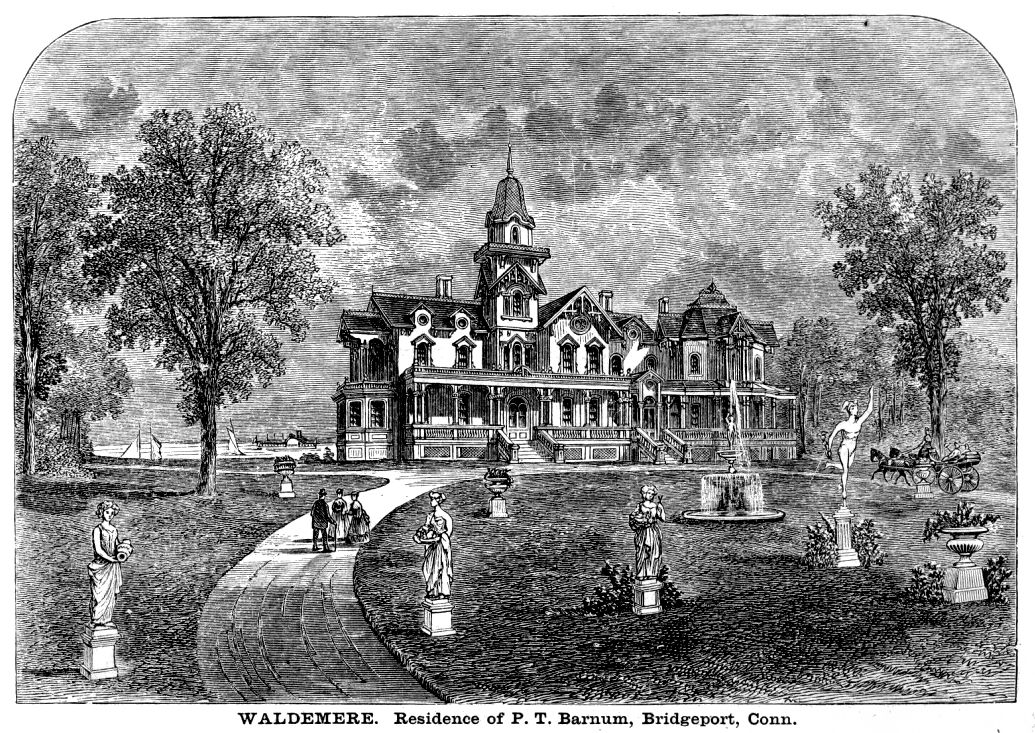

BARNUM'S ROLL CALL.
EIGHTY - THREE MILLIONS!!!
From a careful examination of my account-books for the different exhibitions which I have owned and controlled, I find that more than eighty-two millions of tickets, in the aggregate, were disposed of, and numerous exhibitions which 1 have had at various times are not included in this statement.
The traveling exhibitions which I managed during the six years preceding my purchase of the New York American Museum, in 1841, were attended by 1,500,000 persons.
The American Museum which I managed from 1841 to 1865, when it was destroyed by fire, sold 37,560,000 tickets.
My Broadway Museum, in 1865, '66, '67 and '68, sold 3,640,000 tickets.
My Philadelphia Museum, 1849, '50 and '51, sold 1,800,000 tickets.
My Baltimore Museum sold 900,000 tickets.
My Traveling Asiatic Caravan, Museum and Menagerie, in 1851, '52, '53 and '54, sold 5,824,000 tickets.
My Great Traveling World's Fair and Hippodrome, in 1871, '72, '73, '74, '75 and '76, sold. 7,920,000 tickets.
My other Traveling Exhibitions in America and Europe, sold 2,200,000 tickets.
General Tom Thumb has exhibited for me 34 years, and sold 20,400,000 tickets.
Jenny Lind's Concerts, under my management, were attended by 600,000 persons.
Catherine Hayes' 60 Concerts in California, under my con tract, sold 120,000 tickets.
Thus, my patrons amount to the enormous number of 82,464,000.
Taken altogether, I think I can say that I have amused and instructed more persons than any other manager who ever lived. I may add that I have delivered over seven hundred public lectures, which were attended in the aggregate by 1,300,000 persons. It will thus be seen that "Barnum" has occupied so much public attention for forty years, that the fact need not be wondered at (and it is a fact), that in 1870 a letter mailed New Zealand, and addressed simply "Mr. Barnum, America," came as direct to me at Waldemere, in Bridgeport, Conn., as it could have done if my full address had been written on the envelope. - P. T. B.
P. T. BARNUM.
"Every man is immortal until his work is done." God did not intend that all men should be either priests, evangelists or prophets. The occupations of men are as diversified as their physiognomies. The demands of the race are as imperious and multiform as the laws that govern our physical being. The elements of human character are as separate and distinct as the species in the animal kingdom. The large, soft, placid eye of the gazelle does not reveal more effectually the sweetness and amiability of its character, in contradistinction to that of the indomitable hyena, or the morose rhinoceros, than the fact which is everywhere recognized of the "eternal fitness of things" in that order of Divine Providence which imposes a diversity, not only in facial contour, but of constitutional idiosyncrasies as well.
This diversity in unity, which characterizes the genus homo , is manifest in all the ramifications of human affairs. P. T. Barnum was born to be a showman - but not a charlatan or a mountebank. In an eminent degree he is endowed by nature to cater to the wants and amusements of the great mass of his fellows. The organs of cheerfulness and mirth are very largely developed, but these are kept in admirable subjection to the greater developments of benevolence and veneration. These inhere from the very nature of that austere and rigid system of moral discipline which marked his early childhood, educated as he was under the "blue code" of Connecticut laws. Look at the conformation of that massive head - how evenly and admirably balanced! That is the head which has planned and carried into successful execution the most gigantic amusement enterprise ever conceived in Europe or America. Those are the quick, piercing eyes which take in at a single coup d'oeil the ever-recurring demands of the race for diversion and amusements. A lively conception of the proper relation and utilization of things, a happy predominance of the moral and intellectual faculties; an inherent love of justice and magnanimity, united with a native conscientiousness, cultivated and refined by association with good and great men, have inspired within him an utter contempt for any exhibition which will not repay the visitor an hundred fold for the trouble and expense incurred in witnessing it. For more than forty years he has been intimately identified with the people of both worlds; and so well and favorably is he known as showman, statesman, lecturer, journalist, author and traveler, as well as a founder of cities, and an institutor of the Great American Museum and Colosseum of Natural History and Art, that a bare mention of the name of P. T. Barnum will be quickly understood by the masses, and a synonym for all that can possibly enter into the composition of a successful managerial career. He is, in point of health and vigor, in the very midst of his years. He is capable of bringing to his aid more experience and a riper judgment than ever; and it seems eminently fitting that this last great effort should be the key-stone which is to complete that triumphal arch, the segments of which have been in process of completion for nearly half a century. He appears on the theatre of life's busy stage as modifier and purifier of many of the abuses which have crept into public amusements, and, through his persistent efforts to divest them of immoralities, will challenge the admiration of a carping world. Seated in his palace at Bridgeport (see illustration of Waldemere), he concludes the fiftieth chapter of his book called "Struggles and Triumphs; or, Forty Years' Recollections," with the following paragraphs. They have the true ring of the Christian-soldier:
"My Great Traveling Show is nearly ready to go on the road in 1879. Manager Bailey is to run over to Europe again, to perfect the arrangements already made for introducing several startling novelties, and my show in 1879, with its numerous new features, will be larger and better than ever before.
"As I close this volume in November, 1878, I am more thankful than words can express, that my health is preserved, and that I am blessed with a vigor and buoyancy of spirits vouchsafed to but few men of fifty, or even less; but I am by no means insensible to the fact that 1 have reached the evening of life (which is well lighted, however), and I am glad to know that though this is indeed a beautiful, delightful world to those who have the temperament, the resolution and the judgment to make it so, yet it happily is not our "abiding place," and he is unwise who sets his heart so firmly upon its transitory pleasures as to feel a reluctance to obey the call, when his Father makes it, to leave all behind and to come higher up in the great future where all of that which we now prize highly (except our love to God and our affections for humanity), shall dwindle into insignificance."
So long as he lives Mr. Barnum will devote his experience and his energies to improving and enlarging his Great Traveling Show, so that year after year it shall grow better and better. He will bequeath his show and his name to his heirs in the hope that for ages to come the rising generation shall visit "P. T. Barnum's Greatest Show on Earth" and be amused and instructed by his life-long exertions as a public manager. - G. O. S.
NATURAL HISTORY
INTRODUCTION.
"And God said, Let us make man in our image, after our likeness: and let them have dominion over the fish of the sea, and over the fowl of the air, and over the cattle, and over all the earth, and over every creeping thing that creepeth upon the earth." - Genesis i, 26.
In whatever direction we turn our eyes, we everywhere meet the varied forms of animal life. Earth, air, water, are alike occupied by multitudes of living creatures, each fitted for the habitation assigned to it by nature. To whatever elevation we attain on the mountain sides, to whatever depth in the ocean we may sink the lead, everywhere shall we find traces of animal existence - everywhere find ourselves surrounded by living creatures, in a profusion and variety which may well excite our wonder and admiration.

Nor are these phenomena confined to any one region of the earth; on the contrary the diversity of climate only adds to the variety of objects which one is called upon to contemplate. Thus the bold voyager of the inclement regions of the north, finds, as it were, a new creation; seals basking in the scanty rays of the Arctic sun; the whale rolling his vast bulk in the waves, and ever and anon driving high into the air his curious fountain-water, be it remembered, strained from the myriads of small animals which constitute the food of the leviathan. The land affords a habitation to the elk, the reindeer, the Arctic fox and other creatures peculiar to the regions.
If we turn our attention southwards, to the tropical regions of the earth, the abundance and variety of animated beings increase more and more. Here the colossal elephant, and the equally unwieldy rhinoceros, crash through primeval forests; the lion and the tiger, and other predatory beasts prowl through the thickets, seeking for their prey; on vast plains, countless herds of antelopes browse in fancied security, or dash swiftly away at the approach of danger; gigantic snakes lie coiled in horrid folds amongst the bushes, or hanging from the trees await their victims. The air and trees swarm with birds of gorgeous plumage and insects of strange forms and brilliant colors.
To obtain the endless variety of animals is by no means an easy task. The recital of all the dangers and narrow escapes experienced by Mr. Barnum's wild beast hunters would fill volumes. How different is their stories of the ferocity of the animal kingdom, of their antipathy for man and that picture in the garden of Eden drawn in the poem of Milton:
"About them frisking played
All beasts of the earth, since wild, and of all chase
In wood or wilderness, forest or den;
Sporting the lion ramped, and in his paw
Dandled the kid; bears, tigers, ounces, pards,
Gambolled before them; the unwieldy elephant,
To make them mirth, used all his might, and wreathed
His lithe proboscis; close the serpent sly
Insinuating, wove with Gordian twine
His braided train, and of his fatal guile
Gave proof unheeded."
When we consider the immense number of animals we are soon convinced that an attempt to obtain a knowledge of each of them individually, and without the acquaintance of their mutual relationship, would be a hopeless task. Scientific classification was first adopted by the illustrious Linnaeus, the modern founder of natural history, in 1798.
We find that species unite to form genera , which, in their turn, are united by some common character of importance into families, and these again into tribes. The tribes combine to form orders. The orders, in their turn, group themselves into classes; and these lead us up to certain divisions, five in number. These five divisions stand as follows:
I. PROTOZOA. - II. RADIATA. - III. ARTICULATA. - V. VERTEBRATA. - IV. MOLUSCA.
These, when put together, constitute the Animal Kingdom.
THE QUADRUMANA.
VERTEBRATA - ORDER XII.
It is amongst the highest animals of this order that we find the nearest approach in organization to the structure which characterizes man as an animal. The Monkey tribe varies greatly in size, some of the apes exceeding even man in stature, whilst others are not larger than a squirrel. The number and variety of the Ape tribe is almost legion. They are found in Asia and Africa, South America, and in of the islands of the sea.
Among the more prominent varieties are the Gorilla - a genus considered somewhat apocryphal for many years, but now admitted and classified in the compendium of generic distinctions - the Chimpanzee, Orang-Outang, Siainang, the Lar, silvery and agile Gibbon, the Simpal, the Colobos, Genereza, Grivet, Vervet, White Nose, Patas, Diana, Mangabey, Barbary Ape, Wanderoo, Baboons, Gelada, Chacma, Mandrill, Coaita, Marimonda, Ursine Howler, Capucin, and a hundred other American varieties, not necessary to mention in this place.

The Gorilla has been known for upwards of two thousand years, and was long considered as a species of the human race. It was first mentioned by Hanna, a Carthaginian commander, who thought them to be wild human beings, and he vainly attempted to secure a live specimen. From that time, however, little was heard from travelers respecting this species until the return of M. Du Chaillu from Africa, who brought a stuffed specimen of an adult one with skeletons of others. The agents of Mr. Barnum have been authorized to secure some of these man-like creatures, regardless of cost, and it is hoped that even as we write they may have succeeded in their efforts. The largest Mandrill ever placed on exhibition is in fact the only one of the species (Papio mormon) in captivity. There is a strong ridge on each cheek, which is covered with naked skin; in the Drill this is black, but in the Mandrill it is of a most brilliant azure-blue. The extremity of the nostrils and the lips being of a brilliant carmine in color.
The entire group of Simiadae are but a mockery or caricature of the human race, and no person can investigate these strange imps without reflecting how vast is the difference between the brute and the intellectual creatures whom God has so highly favored. And yet the subtlety, cunning, endlessly varied pranks and tricks of these creatures, show them to be the most subtle and intelligent of any creature of the animal kingdom, man alone excepted.
Nothing in a zoological garden will gather a crowd of eager and grinning spectators quicker than a well-filled cage of these famous caricaturists of the genus homo. It is quite likely that Prof. Darwin himself has obtained much of his theory from the well-known characteristics of these heterogeneous caricaturists of our race. Mr. Barnum never has less than 200 Monkeys of different species at one time in his- menagerie.
THE CARNIVORA.
MAMMALIA - ORDER X, DIVISION V.
THE LION.

The family of Felidae, or cats, has the means of gratifying the predacious disposition developed in the highest degree. Unquestionably the most celebrated species of this family is the Lion, which has, in all ages, been regarded as the personification of courage and magnanimity. For his reputation he has, however, been mainly indebted, like many other impostors, to his noble appearance, which is greatly owing to his possession of a large mane of long hairs. In his habits he is as genuine a cat as the tiger, with whose blood-thirsty disposition the supposed good qualities of the lion have been so frequently contrasted. The Lion is nevertheless, a magnificent and noble creature, well deserving his royal title - rex animalia. The color of the Lion is a tawny yellow, while upon the belly impinges a soft, beautiful light, making a harmonious contrast with the darker hues upon his back and shoulders - in some of the varieties bordering on black, as it becomes more or less blended with the thick, shaggy mane of the male. The ears are blackish, and the caudal extremity is decorated with a long, thick tuft of black hair, which distinguishes the Lion from all other members of the cat tribe. The Lioness is about one-fourth smaller than the Lion, and has no mane of any pretensions.
Among the collection which has been sent to Mr. Barnum, by his agents in Europe, are two Royal Babylonian Lions, and a pair of beautiful Black-maned Lions, second pair ever imported; and, as far as we know, the only Black-maned Lions now in America. The color of the eyes is always the same in all the known varieties, being of bronzed yellow, with black, dilating pupils, and, when excited, or viewed in reflected light, have the flash of fire in them perfectly appalling.
As near as we are able to determine, the average age of the Lion is about thirty years, although he has been known to attain to nearly twice that period. He arrives at maturity in about five years. The length of the mane increases in the male until he is twenty years old; after that time it begins to fade and lose its lustre and brilliancy.
The Lioness usually brings forth her young in the most retired and inaccessible retreats, and, when disturbed, will defend her whelps to the last extremity. In her anxiety to provide for the wants of her little ones, the Lioness will scour the country in every direction, and, at such times, becomes more fierce even than the Lion himself, and has been known to perish in her desperate efforts to secure necessary food. "The old lion perisheth for lack of prey, and the stout lion's whelps are scattered abroad." - Job iv, 11.
Great efforts have been made to domesticate the Lion, but without success. You might as well attempt to change the spots of the leopard. The method of capturing the Lion differs according to circumstances or locality. The old ones are taken by means of a pitfall, kraal, or kloof; but the most successful method is to hunt them in their lairs, and, after dispatching the old ones, to capture the young whelps which are "scattered abroad."
The habits of the Lion and Lioness afford many spirited and ofttimes sublime metaphors to the sacred writers, and give to the Hebrew poets some of the happiest allusions and inspirations found in the Old Testament Scriptures. The "Lion of the tribe of Judah" is one of the sublimest sentiments in the entire apocalyptic vision. "Behold, he shall come up like a lion from the swelling of Jordan." - Jer. i, 44. Isaiah, describing the happy time of the Messiah, says, "The leopard shall lie down with the kid, and the calf, and the young lion, and the fatling together; and a little child shall lead them." "The lion hath roared, and who shall not hear." "The king's wrath is as the roaring lion." Solomon says, "A living dog is better than a dead lion," - showing that death renders those contemptible who are otherwise great, powerful, and terrible. ' "Then went Samson down, * * and behold, a young lion roared against him. And the spirit of the Lord came mightily upon him, and he rent him as he would have rent a kid, and he had nothing in his hand." - Judges xiv, 5, 6. Parallel passages multiply upon the mind, but, fearing the danger of prolixity, we forbear. A number of Baby Lions may always be seen with their mothers in Mr. Barnum's collection.
THE TIGER. (Tigris regalis.)
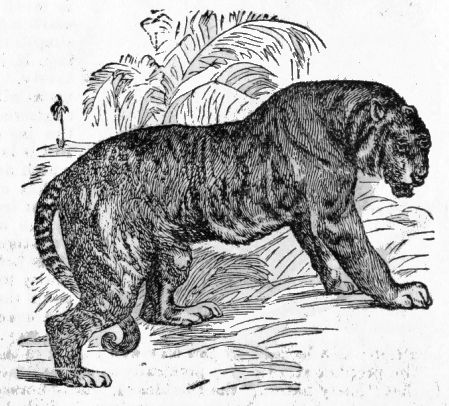
The Tiger is one of the most beautiful of the feline species. In strength, prowess, and agility, it exceeds even the lion; while the softness of its exquisitely-marked fur, the gracefulness of its form, and its supremacy over the beasts of the Asiatic jungles, have won for it the distinguished title of royalty. The Tiger is never found in any other country save that of Asia; and, in Bengal, it sustains the same relation to other animals as the lion does in Africa - that of sole monarch over the kingdom of animated nature. Upon a magnificent groundwork of bright, tawny-yellow is mathematically arranged, nearly at right angles, a series of dark stripes, some single and others double, suggestive of the beautiful stripes of the zebra, which distinguish it from all other varieties of the tigrine carnivora. It varies in length according to climate and condition, the largest and finest specimens being thirteen feet from tip of nose to tip of tail, and about four and a half feet in height. In contradistinction to the well-known habits of all other animals, which are so careful in regarding and protecting their offspring, the Tigress, on the apprehension of danger, suddenly converts her young family into a pioneer band, and sends them out ahead to do picket duty, while she cautiously follows on behind, not the "shadow," but the substance of "coming events." Familiar with these habits, the hunters will allow the cubs either to pass on undisturbed, while they reserve their ammunition to make war on the mother, or will capture one or more of the little whelps, and carry them off into captivity.
The Tiger is not an open, but a dangerous foe. Like the lion, it will stalk an unconscious prey, whether it be man or beast, stealing silently and treacherously upon the unwary victim, preferring a woman or a helpless child for the object of its attack. The localities most frequented by this insidious "terror" of the human kind, are the crossings of nullahs, or the silent ravines through which the water-courses run.
The Tiger is possessed of enormous paws. These are loaded with long, sickle-like talons, with which they deliver a rapid succession of blows, cutting like so many sharp knives, which enable it to strike to the earth the largest animals known to zoology. They have been known to kill and devour the largest ox before abandoning it. They are voracious eaters, preferring the fresh, warm blood as it flows from the wound, and rarely leave a carcass, until devoured, unless driven away. There are several so-called varieties of this animal, usually classified by naturalists as the Bengal Tiger, White Tiger, Brazilian Tiger, and the Jungla, etc. But these distinctions exist more in name than in reality. There is no such animal as the Brazilian Tiger. This unique genus of the cat tribe exists only in Asia. What is commonly described and exhibited through the country as Brazilian Tigers are a nondescript or mongrel, between the American jaguar and puma. Those called White Tigers are mere albinos. The tigrine stripes have become less distinct, through climatic and other influences; the color is partially changed to a creamy-white; but they cannot, upon any principle, either of habit or anatomy, be ranked as permanent varieties. As articles of commerce, the skin, teeth, and talons of the Tiger bring a high market value. The utter extinction of this race of animals is greatly apprehended. Legislation and religious scruples have been the only means of perpetuating his existence. A strange polytheistic mythology has clothed this animal with a sacred mantle, so that it requires much nerve and enterprise to be able to secure them as specimens of zoology to be placed on exhibition. Mr. Barnum has the largest Tigers ever seen in captivity.
THE LEOPARD, (Leopardus varius.)
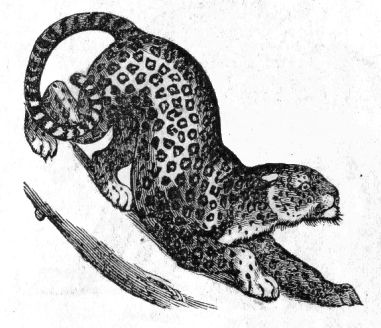
There is an essential and marked difference between the tiger, which is a native of Asia, and the Leopard, which is a native of both Asia and Africa. This beautiful creature is one of the most graceful and agile of the cat tribe. In its dimensions it is much less than the tiger; but in the markings of its skin, and the rosette-shaped configurations of its bodily covering, it is in every respect surpassingly lovely. In its anatomy it does not differ materially from the tiger, or any of its confreres in the Western world, such as the jaguar or puma of South America. But it is possessed of an accomplishment which neither the lion nor tiger can boast - that of climbing and sporting in the forest trees. On this account it is called by the natives of India Lakree-bang , or Tree-tiger. It will crouch among the thick branches of trees, watch an opportunity to seize birds, monkeys, or pounce upon the antelopes, elands, camelopards, and even human, beings, which pass by the way. "Therefore will I be unto them as a lion; as a leopard by the way will I observe them." - Hosea xiii, 7.
The prophet alludes very poetically to the swiftness of this animal, while referring to that "hasty nation," the Chaldeans, whose horses "are swifter than the leopards, and more fierce than the evening wolves." - Hab. i, 8.
THE CHEETAH. (Cynailurus jubatus.)
In its conformation and character this animal seems to combine something of the dog and cat. It has a circular pupil and is chiefly diurnal in its habits. In size and shape it is between the leopard and the hound. The color is yellowish fawn above and nearly pure white beneath. It is covered on the upper parts with numerous black spots from half an inch to an inch in diameter. A slight mane runs along the neck. The intelligence, tractability and fidelity of the Cheetah are such that it has been trained to the chase of the antelope in the East. They are carried to the field in small cages, chained, each one being hooded. When the hunters come in view of a heard of antelopes, a leopard is unchained, his hood removed, and the game pointed out to him; for he is directed in pursuit by his sight. Perceiving the object he steals cautiously along, approaches the herd unseen, and when within killing distance, springs upon his prey and strangles it.
This beautifully-marked, spotted creature has a very ancient history, and figures prominently, in consequence of its bright golden hues, in the Old Testament, forming some of the most beautiful similes of the Hebrew poets. "Come with me from Lebanon, my spouse," says Solomon; "look from the top of Amana, from the top of Shenir and Hermon, from the lions' dens, from the mountains of the leopards." - -Cant. iv, 8.
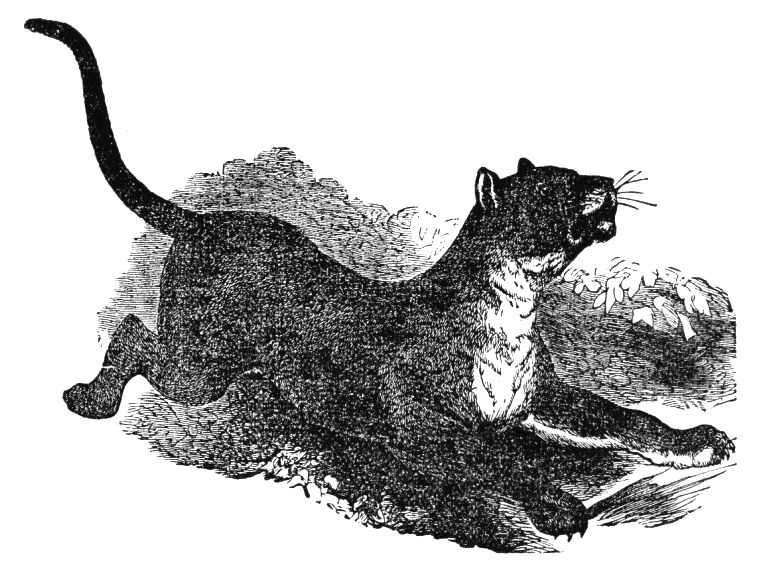
Nimrod, the mighty hunter, is said to have derived his name from the Leopard. If this be so, the well-known predatory habits of that lawless freebooter, whose depredations were not confined to quadrupeds alone. may well be likened to the artfulness and treachery of the Hunting Leopard.
"Proud Nimrod the bloody chase began -
A mighty hunter - and his prey was man."
SPOTTED HYENA. (Crocuta maculata.)
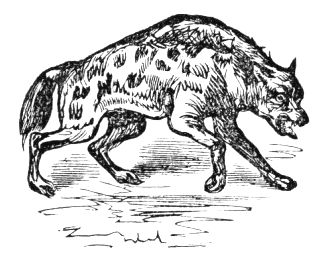
Somehow or other, there is associated with the very name Hyena something that is mean and contemptible. There is in its nature more than is expressed in the picture It sustains the same relation to the animal kingdom as the shark does to the fishes of the sea, or the crow and buzzard to the fowls of the air - a scavenger of no mean pretensions. While we admire the economy of nature, which makes one portion of creation the instrumentality of ridding the earth of putrefaction, we can entertain but little less than contempt for the instrument thus used in its accomplishment. Not so much, perhaps, on account of the instinct of the animal, which compels it to hunt up and devour decomposed or decomposing animal matter, as the abuse of its prerogative in haunting graveyards, and unearthing from their sepulchres the departed dead, and ruthlessly dragging forth to light those whom, through love and affection, we have buried, as we supposed, forever out of sight.
There are several varieties of the Hyena - such as the Crested or Striped, Brown, and the Tiger-wolf or Spotted Hyena - which are found in large numbers in Asia and Africa. The habits of these vary but little; the spotted variety being the largest and most powerful, having jaws and teeth of extraordinary strength, and between their tremendous fangs a human body, or the massive thigh-bones of an ox, fly in splinters with a savage crash that makes the spectator shudder. The skull of the Hyena is of a remarkably solid formation, and so rounded and arched as to give it enormous power. The zygostic arches of bones that extend from the eyes to the ears, and the deep bony crest that projects beyond the brain cavity, serve to attach and knit together the powerful muscles with which this animal is supplied, both in its neck and head. The eyes are wide apart, of a dark, dull, round, repulsive aspect; the muzzle is short; the tongue is rough, thorn-studded, like that of the feline species, for rasping every vestige of flesh from the bones of its prey. The color of the hair is a light brown or gray, with a long crest or mane on the neck and shoulders, and also on the breast and throat, the tail being comparatively short and bushy. It lives in holes, or among rocky, retired p1aces and as the sun sinks in the west, it comes forth in search of food.
The voice of the Striped Hyena, under circumstances of excitement, resembles a most unearthly laugh, whence the animal is commonly known as the "Laughing Hyena." When heard at night it is no wonder that this sound produced a supernatural effect on the fertile imaginations of the Orientals; and there is no doubt that the graveyard demons, or Ghouls of the Arabian Mythology, are merely exaggerated representations of the Hyena. It is described by Pliny as imitating the language of men, to induce them to approach it, that it might make a meal of them more conveniently. Notwithstanding the general opinion of irreclaimable ferocity of the Hyena, it has been tamed, and would follow its master about, and fawn upon him like a dog.
BEARS. (Ursidae.)

There is no class of animals of which more that is interesting might be said than that of the Ursidae, or Bear family. Their history, habits, forms and characteristics are inwrought in the mind of people everywhere. There is no child, however unenlightened in other matters, but has seen or knows something about "Old Bruin." Already crowded for space, which must grow "small by degrees and beautifully less," the reader will accept as an apology a bare mention of this interesting subject.
The family is not so large as it is wide in extent. It is a native of all climes and will be found in some of its varieties, in all parts of the world. From the hot sands of Borneo to Nova Zembla, from the arctic regions to the pampas of Central and South America, in the British possessions, California and Mexico. will this artful and frolicsome creature be encountered. In its natural condition the Bear is comparatively harmless, is capable of domestication. and becomes playful in its frantic comicalities. But, if driven to close quarters, or desperation from hunger, or the females become robbed of whelps, then it is becoming to "stand from under," for there are few Davids who are able to defend either themselves or their flocks and herds from its ravages. During five months of the year there is but little seen of Old Growler, that is, of the American varieties, as he goes into winter quarters and remains in a state of indifferent stupor, requiring no food of any amount, coming out in the spring-time fat and "sleek as a bear."
Among the varieties known to naturalists are the Black Bear, Brown Bear, Grizzly Bear, Thibetan, Malayan and Bornean Sun Bears, Sloth Bear, Cinnamon and White Polar Bears, Poonah, or Large-Lipped Bear, etc. These differ in size materially but in their essential characteristics, never. Their food is composed of vegetables, nuts, fruits, insects, saccharine, and animal matter - being both herbivorous and carnivorous. The Bear is often spoken of as a fierce, savage animal, but we think, with but very few exceptions, the imputation is unjust. It is only when driven by necessity that the Black Bear becomes savage or dangerous. Every species of the Bear family are to be seen in the great International Zoological Garden of P. T. Barnum's New and Greatest Show, including the White Polar Bear so difficult to capture, and to keep alive in a warm climate.
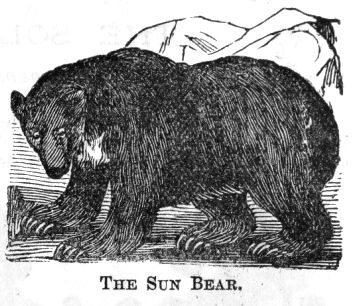
Many expressive metaphors have been furnished by the poets of Palestine, from the well-known habits of this interesting animal.
"Let a bear robbed of her whelps meet a man, rather than a fool in his folly."- Prov. xvii, 12.
"I will meet them as a bear that is bereaved of her whelps, and will rend the caul of their heart." - Hosea xiii, 8.
THE BADGER. (Meles taxus.)
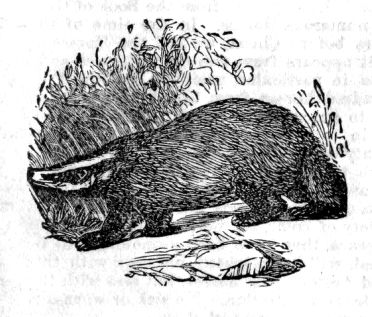
The American Badger, as compared with the European, is generally less in size, and of a lighter make; the head, though equally long, is not so sharp towards the nose, and the markings on the fur are remarkably different. A narrow white line runs from between the eyes for some distance towards the back, the rest of the upper part of the head is brown, the throat and whole under jaw are white, the cheeks partly so; a semi-circular brown spot is placed between the light part of the cheeks and the ears.
The American Badger frequents the sandy plains or prairies, which skirt the Rocky Mountains, as far north as latitude fifty-eight degrees. It abounds on the plains watered by the Missouri, but its exact southern range has not been defined by any traveler. The sand-prairies, in the neighborhood of Carlton-house on the- banks of the Saskatchawan, and also on Red River, that flows into Lake Winnipeg, are perforated by innumerable badger-holes, which are a great annoyance to horsemen, particularly when the ground is. covered with snow.
Whilst the ground is covered with snow, the Badger rarely comes from its hole, and it passes the winter in that climate, from the beginning of November to April, in a torpid state.
THE SOLIDUNGULA.
EQUIDAE. - ORDER V, DIVISION V.

This order has been established for the reception of the Horse and its allies, forming the single family of the Equidae. So common is this family, that it is only to endeavor to show how much can be accomplished by kind treatment and proper training that we refer to them. All species of the Equidae or Horses are originally natives of the Old World. At a very early period, as appears from the Book of Genesis, the Egyptians undoubtedly possessed numerous Horses. In the time of the prophet Ezekiel, or nearly six hundred years before Christ, we find the Horses of Logarmah, or Cappadocia, referred to; and it appears from various writers of antiquity that these were highly prized. Strabo, in particular, mentions that the Persians took an annual tribute of fifteen hundred horses from that province For years the European rulers have endeavored to procure a strain of pure bred horses with blood as blue as that which circulated in their own royal arteries. Mr. Barnum has succeeded in procuring over twenty of these royal stallions from their crowned masters. Placing them under the tuition of the accomplished trainer, Mons. Carl Antony, Jr., Chevalier d'honneur,and Master of the Horse to His Majesty the Emperor of Germany, they have been taught to perform a series of the most wonderful evolutions. For beauty and variety of color, for perfection of form, for superb action and almost miraculous intelligence, they have been pronounced to be without equal. The lovers of good horse flesh will be delighted, not only with this school of imported stallions, and full blooded Arabian ring horses, but also with the hundreds of team horses, which always challenge admiration. No sick or worn-out horses are allowed by Mr. Barnum, to be seen with his greatest show.
THE ZEBRA. (Equus zebra.)
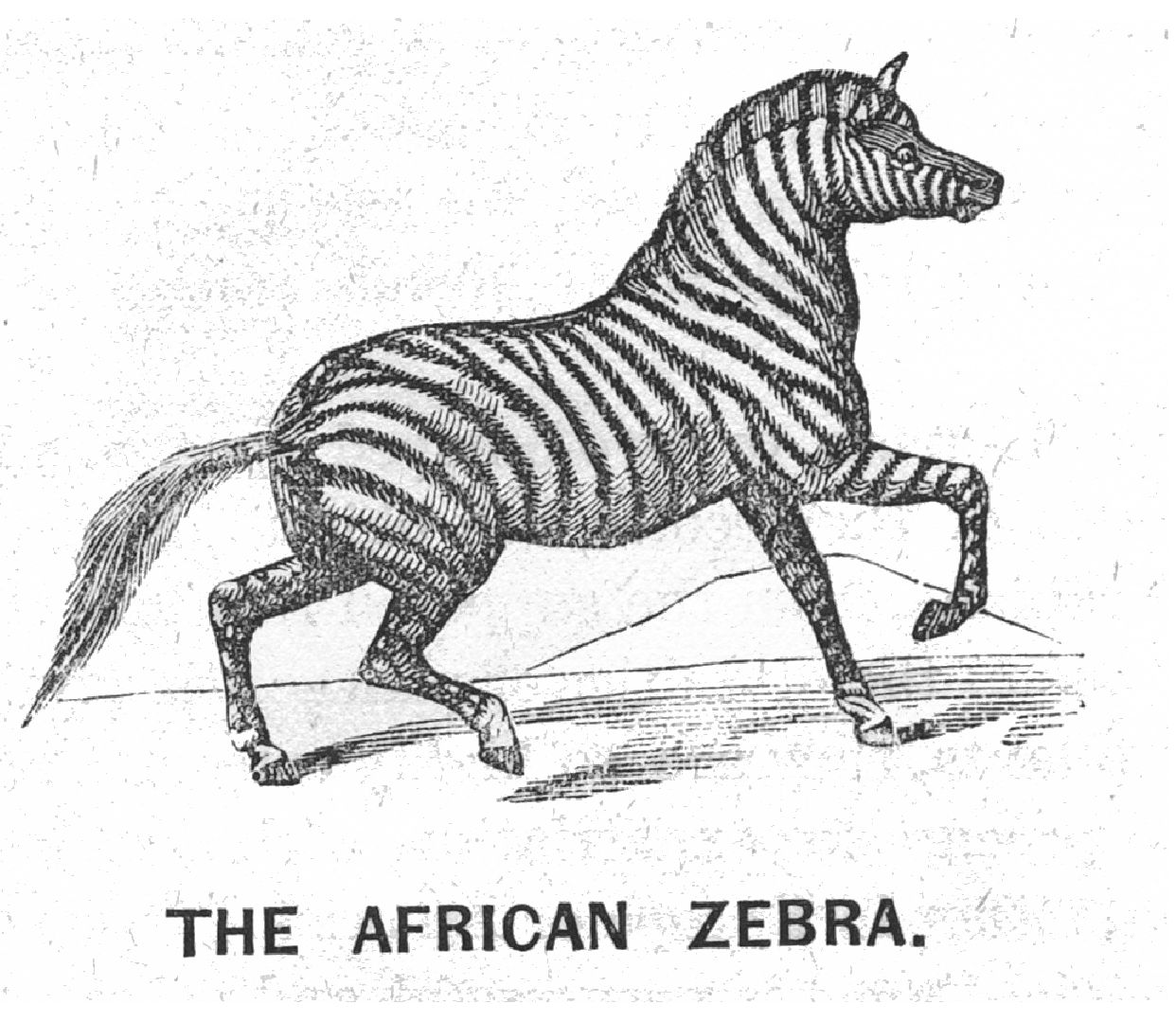
The Zebra is perhaps the handsomest and most elegantly clothed of all quadrupeds. He has the shape and grace of the horse, the swiftness of the stag, and a striped robe of black and white alternately disposed, with so much regularity and symmetry, that it seems as if nature had made use of the rule and compass to paint it. These alternate bands of black and white are so much the more singular as they are straight, parallel, and very exactly divided, like striped stuff; as they extend themselves, not only over the body, but over the head, thighs, legs, and even the ears and tail; so that at a distance, this animal appears as if he were surrounded with little fillets, which some person had disposed in a regular manner over every part of the body. In the female these bands are alternately black and white. In the male they are brown and yellow, but always of a lively and brilliant mixture, upon a short, fine, and thick hair; the lustre or which increases the beauties of the colors. It is in general less than the horse and larger than the ass - although it has often been compared to these two animals, it is like neither of them,
His disposition is ugly, fierce, and indomitable. His ranges are among the mountainous districts of Senegambia, which he prefers to the arid plains of Abyssinia and Central Africa.
Prof. Rarey, the celebrated horse-tamer, encountered more trouble in his efforts to subdue one of the Zebras of the British Museum than all the wild horses on the Continent. Like a Mississippi mule, it will kick viciously with all four of its feet, and laugh to scorn all attempts at domination or subjection. The specimen connected with this exhibition is remarkably fine and well-proportioned.
THE HORNED HORSE. (Equus cornus.)
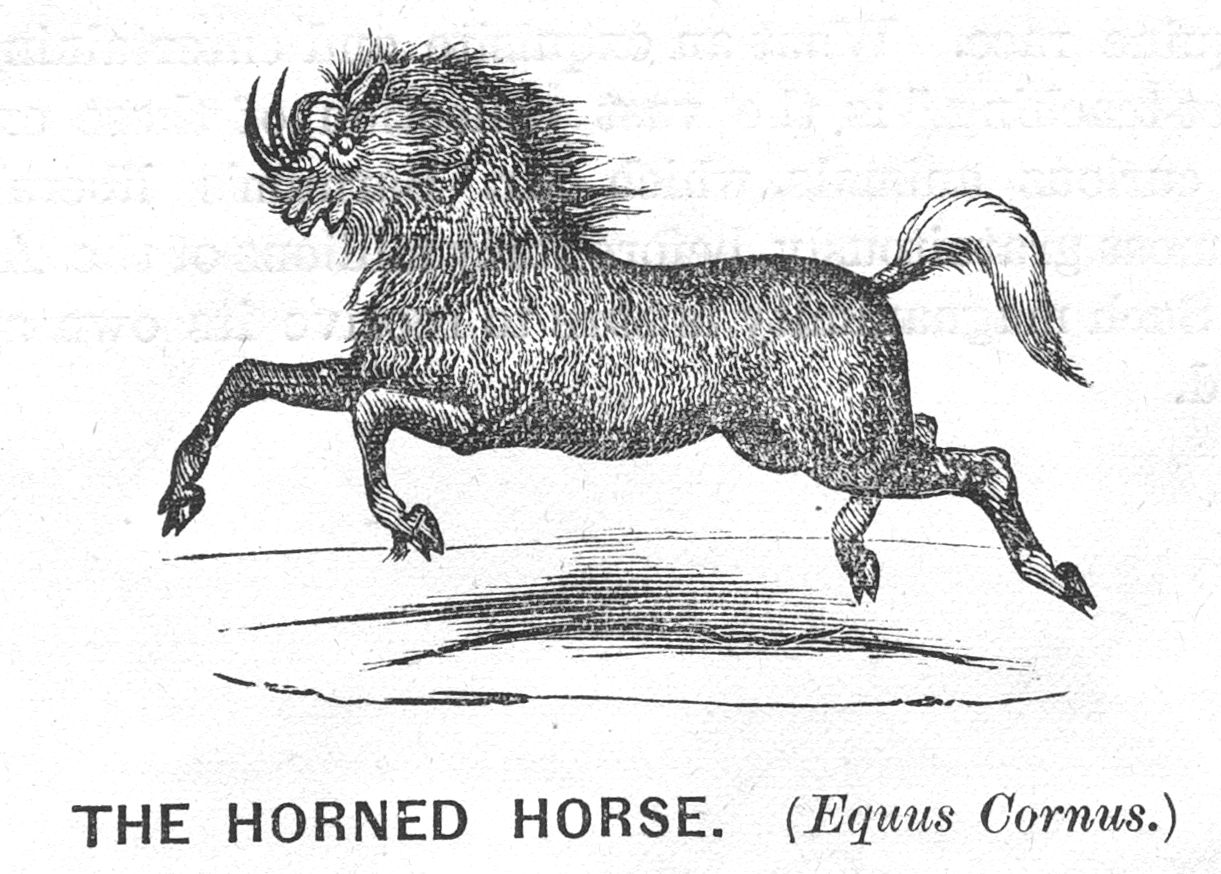
The existence of such an animal as a Horned Horse, in the zoologic sense of that term, although frequent attempts to verify it have been made by naturalists of some pretensions, is, from the best sources of information within our reach, somewhat apocryphal. There is, however, an animal very much resembling the wild horse found in Tartary, with horns growing out of his head, somewhat similar to the Cape Buffalo – the Impoofo, or brindled gnu - but, on close examination, proves to be closely allied to the bison tribe. The noble creature imported by the proprietor of this establishment differs materially from any ever before exhibited in this country. It has been supposed by some to be the same animal which Job called the "Unicorn," although, if that be the case, it is a misnomer, as that implies an animal with a single horn.
What an exquisite and entertaining school for "object-teaching" is the vast collection of these extremely rare and curious animals, which Mr. Barnum's liberality has placed, almost gratuitously, before forty millions of the American people! Such magnanimity is sure to receive its own appropriate reward.
RUMINANTIA.
ORDER VI, DIVISION V.
THE CAMEL. (Camelus dromedarius.)
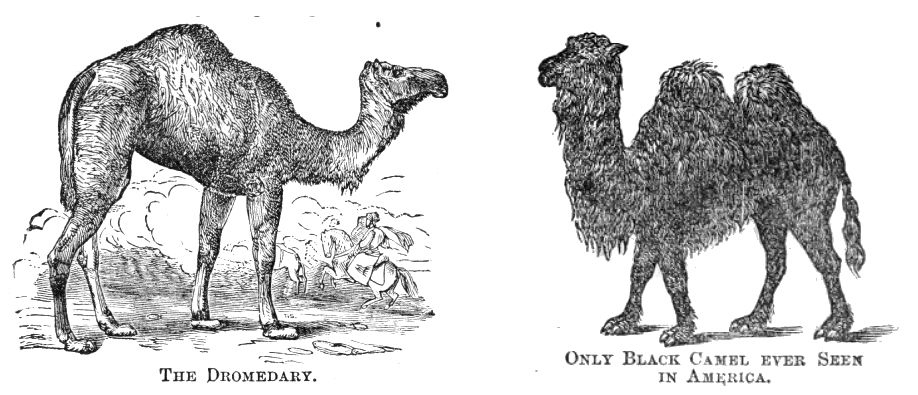
This animal seems destined by nature to fill a very important part in the affairs of mankind. Its height ranges from six to eight feet. Upon the back of the Arabian Camel is a single large adipose excresence called hump; upon that of the Mecheri, or Bactrian Camel there are two humps - these being the leading characteristics which distinguish the two species. The color of the single-humped animal is a light brown, with occasional variations of shade, from dark to a dirty white. Among the Bactrian or double-humped species, these variations are more marked in contrast, occasionally there being found one almost white. The one belonging to this Menagerie is of this description, and, with a single exception, the only one of the kind now in the country.
The Dromedary, though not a separate variety, differs somewhat from the common Camel. It is not so large or so well adapted as a beast of burden, but is very fleet of foot, and ordinarily used to make rapid transits across the arid sandy deserts of Arabia. The unusually large herd of Camels exhibited in Mr. Barnum's collection were purchased a few years from King Theodorus of Senegambia, taken by Mons. De Lesseps to work on the Suez Canal, and, at the conclusion of that gigantic enterprise, sold to Mr. Barnum's agents in Europe at an enormous price.
Camels are very intimately connected with ancient history, sacred and profane, as they figure conspicuously in the affairs and wealth of Oriental princes in all the past. Job is said to have had three thousand, while the sons of Reuben captured from the Hagarites, in one battle, fifty thousand of these useful allies. They have often been used in war to carry the baggage of Oriental armies, and even to mingle in the bloody tumult of hand-to-hand combats.
The hair of the Camel is very useful and valuable as an article of commerce. Cloth made from this material was worn by the ancient prophets and princes of Israel. John the Baptist appeared in Galilee in a raiment of Camel's hair, made after a coarse and rude manner, in striking contrast with those who dwelt in palaces and wore "soft raiment." The legs are large and muscular, supported by very large, broad elastic hoofs or feet, while the body is withered into proportions narrow and economic, provided internally with a "reticulum" of honey-comb cells, in which a large quantity of water may be absorbed, sufficient to endure the deprivations of a transit across the dreary desert.
The only pure Black Camels ever in America are those belonging to Mr. Barnum. They are found only in Bucharia, Cabul and some other parts of Persia. They are regarded by the people residing in those places as a present from heaven, and therefore a sacred beast. It is therefore utterly impossible to obtain their consent to their importation. The ones now presented for the first time to the American public were a gift to the "Great Showman" from the High Priest of the Brahmins
THE LLAMA.
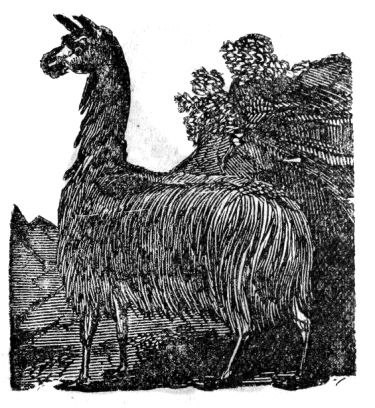
These animals, which appear like small camels, and represent them in the New World, are, however, readily distinguished from them, not only by the difference of size, but by the absence of dorsal humps and complete division of the toes. This structure of the feet does not adapt them for traveling over such sandy wastes as form the natural home of the camel, but for dwelling on mountains and among rocks, where, in point of fact, their footing is more sure than that of most other animals. Their form is lighter, and more elegant than that of the camel. Their native region is upon the slopes of the immense chain of the Andes, in South America, on all parts of which they occur; and although inhabitants of the tropical climate they are very impatient of heat, and often ascend into the vicinity of the line of perpetual snow. The wild Llamas are very vigilant and shy; they live in flocks at a great altitude upon the mountains, and only descend towards the plains occasionally in search of food. When irritated they eject the contents of their mouths upon the offending party; the substance discharged is exceedingly disagreeable.
When killed, its flesh furnishes an excellent food; and the long woolly hair with which it is covered forms the principal clothing of the Indians. The skin furnishes a good leather.
THE MOOSE, or ELK. (Alces malchis.)
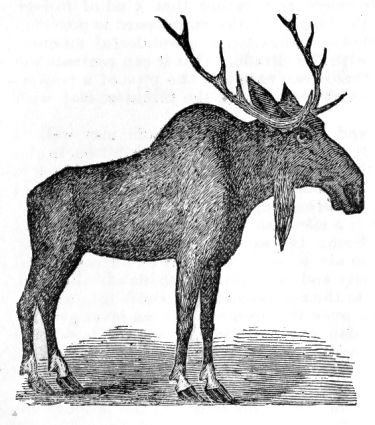
In some portions of Europe, an adult male Moose attains to enormous proportions, being nearly as large as a medium-sized elephant. It is the largest of the deer tribe, and has horns of great reach and breadth, widely palmated at their extremities, and so ponderous in weight as to challenge our wonder, it not admiration, at the facile manner with which this magnificent animal wields them. In America, where this noble animal was formerly found in large numbers, it is better known as the Elk. The muzzle is extremely large and lengthened in front, which imparts to the countenance of the Elk an expression decidedly unique, while the nostrils are widely distended, rendering it keen and quick-scented to detect the presence of an unseen foe. Its color is dark-brown, that of the legs being blended with yellowish-white hues, and, with its massive horns thrown gracefully back upon the shoulders, the animal presents a picturesque appearance, notwithstanding the awkwardness of his gait.
In many localities of the United States, beautiful villages have sprung up into existence, called ‘'Elkland," from the large numbers of these majestic animals found during the earlier settlements of the New World, However, like many of the undisputed wild denizens which occupied these primeval forests in by-gone days, they are slowly but surely passing away.
THE GIRAFFE. (Giraffa Camelopardalis.)
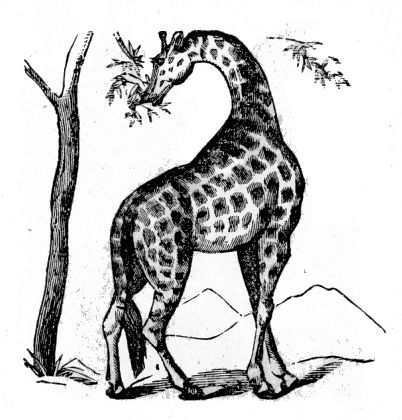
The height of a full-sized male Giraffe is from eighteen to twenty feet - by far the tallest and most stately of all the dwellers that ever walked on the face of God's earthly heritage. It is an inhabitant of the various parts of Africa, the color of the coat being darker in the southern than that of the northern regions of that fer tile abode of the most marvelous of the zoologic race. It towers above its fellows, unique in its proportions, mild in disposition, majestic in mein, and peer less in the lustre of its large, loving eyes. There are in the neck of the Giraffe seven vertebrae, the same as other animals; but they are extremely elongated, while the articulation is admirably adapted to the purpose they are called upon to fill.
On first looking at this beautiful animal, one would suppose that the fore legs were longer than the hinder limbs. This, however, is not the fact. The apparent difference lies in the remarkable elongation of the shoulder-blades, and the great depth from the withers to the carotid veins. From the highest point of the shoulder to the caudal there is a gradual slope, or declination, of from twenty to forty degrees, which precludes the possibility of ever making the Giraffe a beast of burden. Upon the head of this strange animal grow two excrescences, resembling obtuse horns - a kind of ossis fungi, in substance bearing a striking likeness to the first developments of the antlers on the heads of the fallow deer. These quasi horns are covered with skin, and on the extreme top protrudes a bush-like tuft of dark hair. Lower down on the forehead, and nearly between the eyes, is another osseous projecture - a kind of apologetic imitation of the horn of the unicorn As the Giraffe browses almost exclusively on the leaves of the forest trees, how entirely in accordance with the will of a Divine Providence has this marvel of the animal kingdom been physically endowed! In order that it might be able to select and gather that kind of foliage best adapted to a palate of exquisite taste, the tongue of the camelopard is provided with prehensile power, capable of contraction or elongation in a wonderful manner. We are informed by those most familiar with the Giraffe, "that it can contract the tip of its tongue into so small a compass that it can pass into the pipe of a pocket- key," while its prehensile powers enable its owner to pluck the minutest leaf with perfect ease.
By its well-known habits of gentleness and playfulness, the Giraffe may well be denominated the coquette of the antelope tribe. When placed on exhibition in the menagerie, it seems to be delighted with the advent of numerous visitors, whom it scrutinizes in the most bewitching and gallant manner, being an enthusiastic admirer of the gay, fantastic attire in which ladies sometimes appear.
Like the eland and kangaroo, the Giraffe is a silent animal, never uttering a sound as an expression of pleasure, or while suffering the agonies even of death itself. Elevating its graceful neck and head high in air when attacked by an enemy, it will deliver a shower of kicks with such celerity and precision as to daunt the lion, which it sometimes sends coweringly away to the nearest jungle. On rough, uneven soil, the Giraffe possesses great advantage over the hunter; but on level ground, the Kaffre Nimrods, mounted on their Pegasian chargers, will spring the lasso over the head of his spotted highness, and soon overpower him by means of the rope to which he is now helplessly tethered. Another method of capturing the Giraffe is by means of stalking, and the pit fall - identically the same as is used for trapping the rhinoceros and hippopotamus, only the sharp stake for impaling the latter is not used in the capture of the former.
The color of the Giraffe is a pale, ofttimes creamy light, with large, irregularly- shaped spots covering the neck and body. Its hide is enormously thick and obdurate, capable of resisting almost any force the native hunters, with their imperfect weapons, are capable of hurling against it. It is not easily killed; and yet, as strange as it may appear, it is one of the most difficult of the animal kingdom to acclimate, and made to subserve the purposes of a traveling exhibition. During the last eighteen months Mr. Barnum has lost three of these valuable animals while crossing the Atlantic, which cost from $4,000 to $8,000 apiece. In fact, nearly all the showmen of the country have abandoned the idea of attempting to furnish these expensive creatures at all. Those belonging to Mr. Barnum were secured through the indefatigable labors of his agents in Abyssinia, and are the only living Giraffes on the continent of North America.
AFRICAN ELAND. (Oreas canna.)
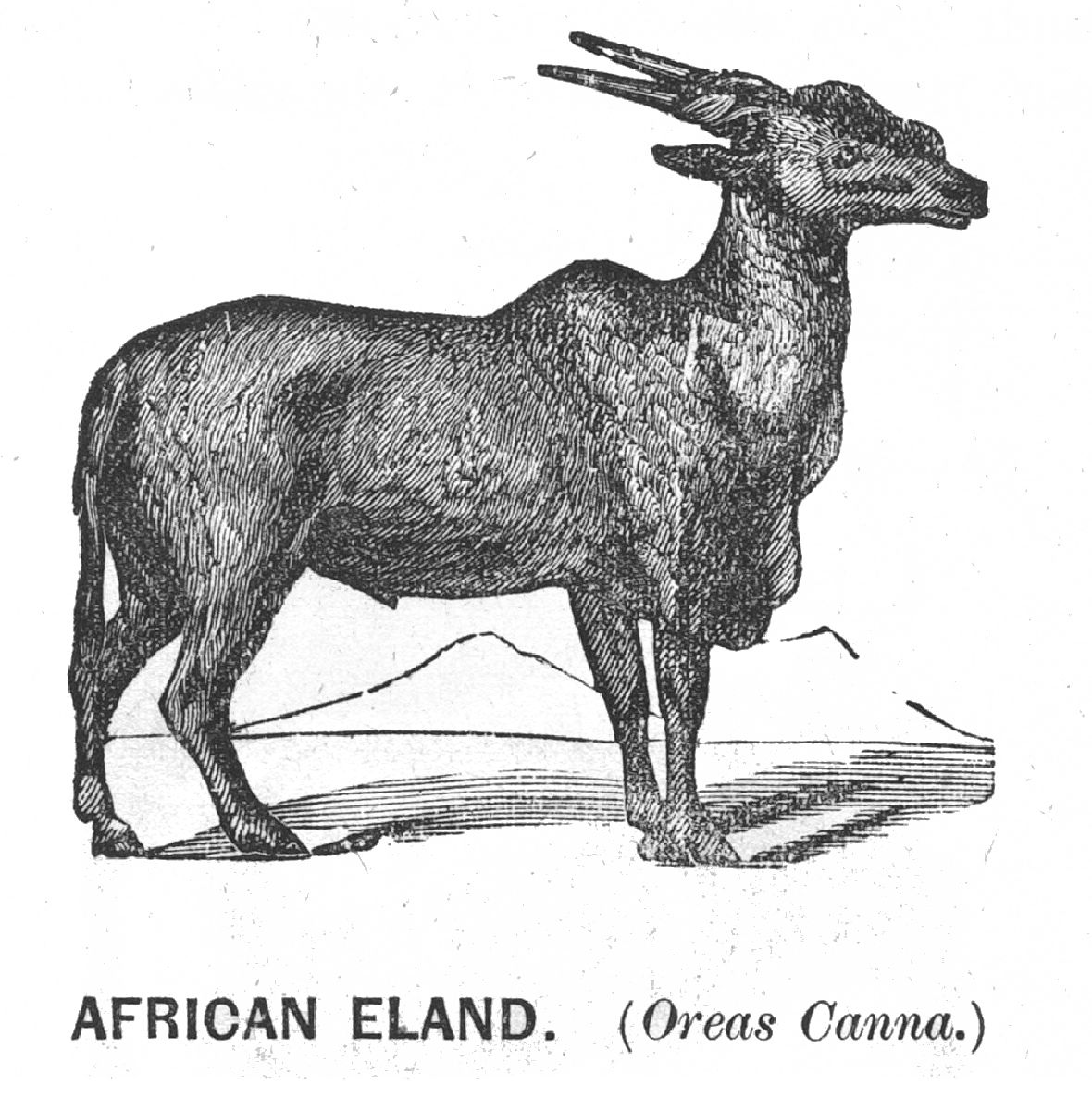
The Eland, or Impoofo, is one of the most ponderous of South-African antelopes, and frequently attains the dimensions of a very large ox. The first specimen sent to Mr. Barnum was over six feet in height, and such was its enormous size and weight, that it was unable to endure the stormy mid-winter passage across the Atlantic.
Mr. Barnum, the enterprising proprietor of this exhibition, not to be baffled in his purpose of bringing together the largest aggregation of animals ever witnessed in America, forthwith telegraphed to his agent in Europe, and we have the satisfaction of announcing the arrival of another magnificent specimen, which will be found among the antelope collection.
Its flesh is excellent for food, being tender and delicious - a thing most remarkable, when we remember that the meat of most all other animals in Africa, according to the testimony of African explorers, is as dry and tough as sole-leather. As with the camel, so with the Eland; we behold in the economy of its nature the handiwork of an All-wise Creator, which enables it to subsist for months without drinking water. Its color is a pale grayish-brown, tinged with fawn-like stripes dimly outlined on the body of some of the varieties, while the horns are of large size, nearly straight, and spirally twisted. It is extremely ravenous in its appetite for food, the daily rations required making no small demands upon the exchequer, so that what it lacks in liquids is more than compensated in the extra demands for solid matter.
THE YAK. (Poephagus grunniens.)
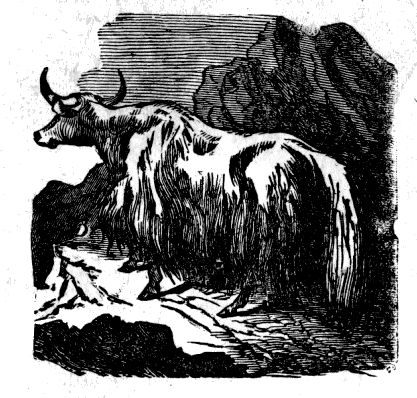
This rare specimen of the bovine race, as its name implies, is called, by the natives of Asia the Yak or Grunting Ox. The Yak is found among the highest plateaus of the Thibetan Mountains, ranging between the Altai and the Himalayas. It is easily domesticated, and is often brought into requisition to subserve the purposes of man. It is a large, handsome animal, with a high head and a proud look, challenging the admiration of all who behold it. The above cut gives a good illustration of its bodily conformation. The large heavy fringes of hair which depend from the sides and lower parts of the body, and the thick silken tufts of its bushy tail, are extremely valuable as articles of commerce, and constitute one of the staple fancies which decorate the wardrobe of our fashionable belles. It is dyed into all sorts of brilliant colors, and is extensively used to embellish the caps of Chinese officials. The tail of the Yak, when highly colored, is carried before officers of state in their anniversary pageants, the number used indicating their rank.
The specimen sent to Mr. Barnum, from China, by Gen. Tom Thumb, is the only one of this variety ever placed on exhibition in this country.
THE PACHYDERMATA.
ORDER IV, CLASS MAMMALIA.
THE ELEPHANT. (Elephas Indicus.)
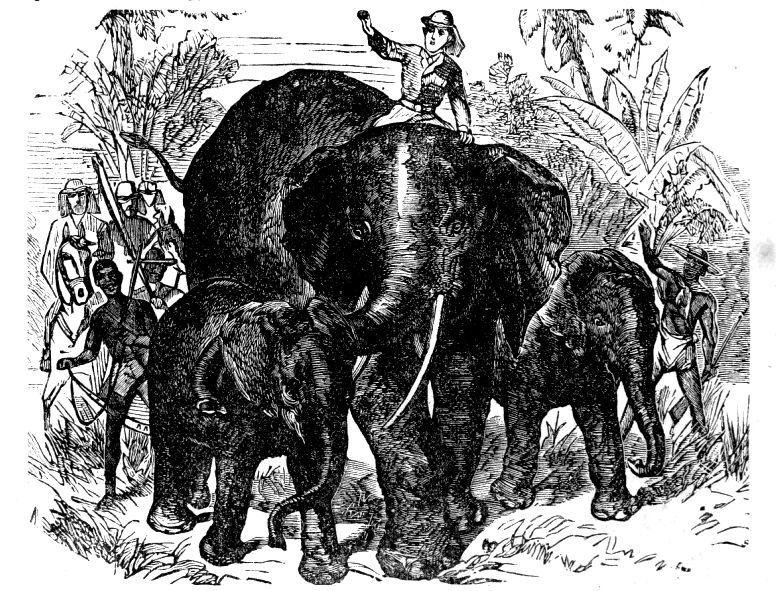
The Elephant is the largest and most ponderous of the pachydermata, or thick- skinned animals, and, since the days of the mastodon, is one of the most gigantic specimens of zoology known to the human race.
There are found two distinct species, which are well known as the African and Asiatic Elephants. The latter will always be known by the dimensions of the head and ears - one of the most noticeable points of distinction existing between them. The head of the Asiatic Elephant is somewhat elongated, the forehead concave, and the ears of an ordinary size; while the head of the African Elephant is much shorter, the forehead convex, and the ears of great breadth and magnitude, covering nearly a sixth of the entire body. Among the Asiatic Elephants only the male portion are supplied with tusks, while both the male and female of the African species are equally furnished with the long projecting ivories. Both varieties are gregarious - always going in herds, and, when about to cross a river or any body of water, send the smallest first, so that, in case of accident or foundering, the larger ones can come to the rescue.
One of the strangest, yet most useful appendages of the Elephant, is his trunk, or proboscis. This feature of the animal seems to be an extraordinary development of the upper lip or nose. It is perforated through its entire length by the nostrils, and, at the tip of the trunk, is supplied with a finger-like appendage, by means of which it is enabled to pick up objects of the most diminutive size, or thrust it into the vest pockets of the by-standers, and triumphantly seize the most trifling bijou that may be concealed therein. The trunk of this huge animal performs a very important part in his well-being; for, without it, he would very soon starve to death or perish. With it he supplies himself with both food and water. It is not only possessed with great flexibility, capable of extension and contraction, but also with enormous strength.
If we investigate the anatomy of this wonderful creature, we will find that the hoof which incloses the foot is composed of a vast number of horny plates, arranged on the principle of the carriage spring, by means of which the tread of the Elephant is as light, noiseless, and elastic as any of the cat tribe, barring, of course, the vast difference in size. "The points of a good Elephant," says the Rev. J. G. Wood, "are as important in India and Ceylon as those of a horse in Europe." The softness of the skin, the red color of the mouth and tongue, the forehead expanded and full, the ears large and rectangular, the trunk broad at the root and blotched with pink in front, the eyes light and kindly, the cheeks large, the neck full, the back level, the chest square, the fore-legs short and convex in front, the hind quarters plump, five nails on each foot, all smooth, elastic, and round; these are the points of the famous Elephant which was used by Mr. Barnum on his farm in Bridgeport, Ct., for plowing and agricultural purposes. This same Elephant, together with several still larger, and a baby Elephant, are now connected with the Great Traveling Zoological Garden. Mr. Barnum is entitled to the credit of converting the first Elephant into a husbandman, or testing his adaptability for general agricultural purposes.
Mr. Barnum, in his last best book, or autobiography, so full of interest and anecdote of "Struggles and Triumphs; or , Forty Years' Recollections of P. T. Barnum " (one of the most charming and interesting productions of his graphic and ofttimes brilliant pen, that ever issued from the press), nine hundred pages, thirty-two full page engravings, reduced from $3.50 to $1.00 - gives us some very laughable in stances of his attempt at farming with an Elephant, and says: "Hundreds of people came many miles to witness the novel spectacle. Letters poured in upon me from the secretaries of hundreds of State and County Agricultural Societies throughout the Union, stating that the presidents and directors of such societies had requested them to propound to me a series of questions in regard to the new power I had put in operation on my farm. Among these were:
1. Is the Elephant a profitable agricultural animal? 2. How much can an Elephant plow in a day? 3. How much can he draw? 4. How much can he eat? 5. Will Elephants make themselves generally useful on a farm? 6. What is the price of an Elephant? 7. Where can Elephants be purchased?
"I suppose," continues Mr. Barnum, "some of my inquirers thought the Elephant would pick up chips, or even pins, as they have been taught to do, and would rock the baby and do all the chores, including the occasional carrying of a trunk, other than his own, to the depot." While this gigantic co-operative in the primordial occupation of man was daily engaged in the pursuits of the farm," newspaper reporters," continues the famous autobiographer, "came from far and near, and wrote glowing accounts of his elephantine performances. One of these reporters said: ‘Barnum's Elephant built all the stone walls on the farm; made all the rail fences; planted corn with his trunk and covered it with his foot; washed my windows and sprinkled the walks and lawns by taking the water from the water fountain with his trunk; carried all the children to school, and put them to bed at night, tucking them up with his trunk; fed the pigs; picked fruit from the branches that could not otherwise be reached; turned the fanning-mill and corn-sheller; drew the mowing-machine, and turned and cocked the hay with his trunk; carried and brought my letters to and from the post-office (it was a male Elephant), and did all the chores about the house, including milking the cows and bringing in the eggs."
The modes of capturing wild Elephants are numerous. One is to pursue a solitary individual in the wilds of the thick forest, and entangle him with a network of massive ropes. Another is by driving a herd of Elephants into a previously pre pared pound, kraal, or "keddah," and then secure the entrance to prevent escape.
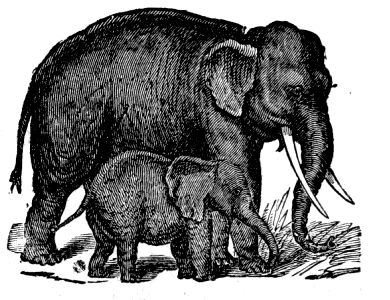
Elephants in captivity are frequently seen, as almost every large show that travels through the country is possessed of one or more of them; but they are such an interesting creature, and form so striking a feature in the make up of a show, that they always seem to be invested with new interest, being objects of universal observation. Those connected with P. T. Barnum's Mammoth Traveling Museum and Zoological Garden are magnificent representative specimens, ten in number, several of them being performing or trick Elephants. The Asiatic varieties are the most valuable, and usually the best travelers. They are sometimes rendered very serviceable to a menagerie, as they will push heavily-loaded wagons up a hill, or assist wonderfully in extricating them from muddy roads, pit-holes, and deep morasses. Mr. Barnum has now the largest herd of wild elephants - eleven in number - ever before seen in a single exhibition.
THE RHINOCEROS. (Rhinoceros unicornus.)
The Rhinoceros is one of the most remarkable of the pachydermatous mammalia, closely allied to the elephant, tapir, and the hippopotamus. There are several varieties still extant, many of the earlier species having become extinct, which can only be recognized by their fossiliferous remains. There are two or three species found in Asia, Sumatra, and Borneo, while there are several inhabiting the various portions of Africa.
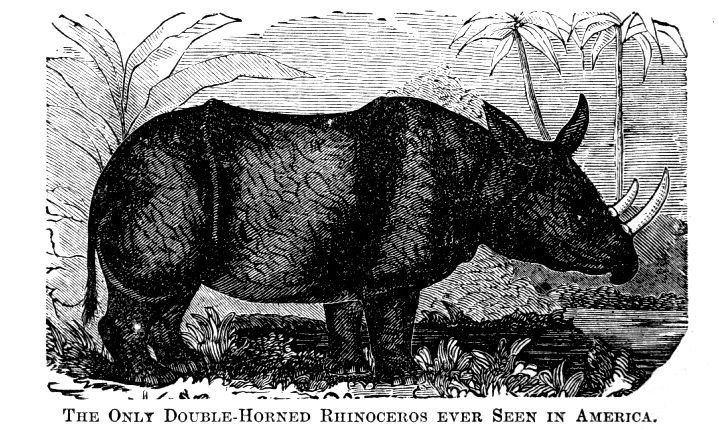
There are a few characteristics common to all the varieties of this remarkable group: one is the almost uniform conformation of the body, excepting size, and the other is the horny projection from the nose, the Indian Rhinoceros having but one, while the African varieties have two. This so-called horn is of peculiar structure, and is no way connected with the skull. It seems to be developed exclusively from the skin, and belongs to the same rank as the hirsute, bristles, spirus, and quills of other animals. They grow with the development of the animal, until they become long, sharp, and inflexible, capable of doing fearful execution as a weapon of aggressive or defensive warfare. If closely examined, these cornia will be found hard and smoothly polished at the tip, while the base is rough and split into innumerable filaments, constituting a kind of cushion to soften the concussion caused by its frequent onsets with its enemies. He is an ugly and disagreeable brute, utterly devoid of any sense of gratitude, and irate to the last extreme. No amount of good treatment or caressing will avail with him. In every species, whether of the unicornus or bicornus varieties, the Rhinoceros is defective in sight, from the fact of his not being able to see objects perfectly, in front of him, so deeply are his eyes set in his head. The skin of the Rhinoceros is very thick, capable of resisting the force of an ordinary bullet. In the Asiatic species, the heavy flabby folds in which the skin is gathered hang massively over the shoulders, throat, flanks, and haunches, which give the animal a very rough, uncouth appearance. The skin upon the abdomen is comparatively soft, which, like the heel of Achilles, seems to be the only vulnerable point of attack. The horn of the Indian Rhinoceros is not so long nor well developed; yet, even with this short weapon, he is capable of doing fearful execution in ripping up the earth and defending himself against the onsets of the largest elephants, against many of which he is represented, by experienced hunters, to be more than a match. The average height of the Rhinoceros is about four feet, although they have been known to attain to six feet. Its color is dark purplish brown, approximating, in some of the Borele varieties, to a deep black.
King Ava, who glories in the title of "Lord of the White Elephants," generally monopolizes every white elephant and rhinoceros in his domain, as he employs them, especially the former, in state processions and parades, decorating them with rich ornaments of gold and priceless jewels, quartering them in the most magnificent houses of state. Mr. Barnum, has recently offered $25,000 each for a white elephant and rhinoceros, safely landed on the dock in New York city; and he hopes, therefore, through the influence of his personal friend, Lord Bright, whose son is en bon rapport with the royal court of the "Lord of the White Elephants," to be able to gratify the curiosity of his American friends, although at a fabulous price, by affording them an opportunity of seeing the first white elephant and rhinoceros ever witnessed in America.
SOUTH AMERICAN TAPIR.
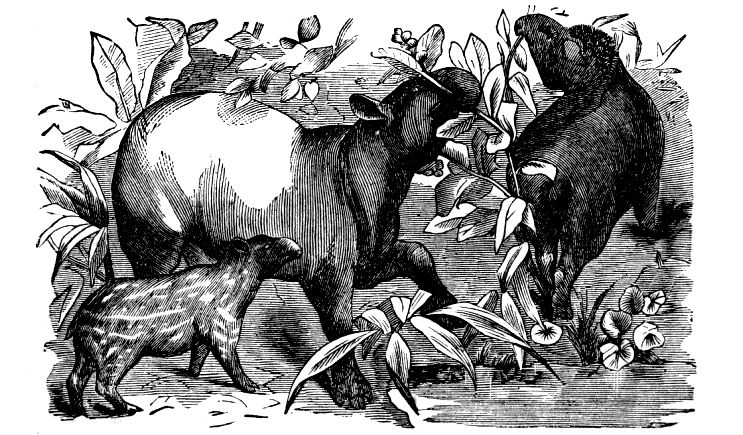
In many respects the American Tapir differs from that of the Malayan. It is found in large numbers in Central and South America, always in the vicinity of rivers, preferring the thick coverts of dense forests, whence they issue only by night, in search of food. The American variety are good swimmers and divers, and very often elude their pursuers by suddenly plunging in the water and diving out of sight, or so concealing themselves among the shrubbery, brakes and water-lilies, as to avoid detection. Its thick tough hide is capable of protecting the animal from thorns, brambles and thick craggy branches of the forest-trees, through which it passes on its headlong way during the darkest midnight hours. The Tapir, though a large, bulky animal, falls an easy prey to the jaguar, which, concealing itself in the overhanging branches, springs suddenly upon the back of the poor brute, and strikes it to the earth.
THE MALAYAN TAPIR. (Tapirus Malayanus.)
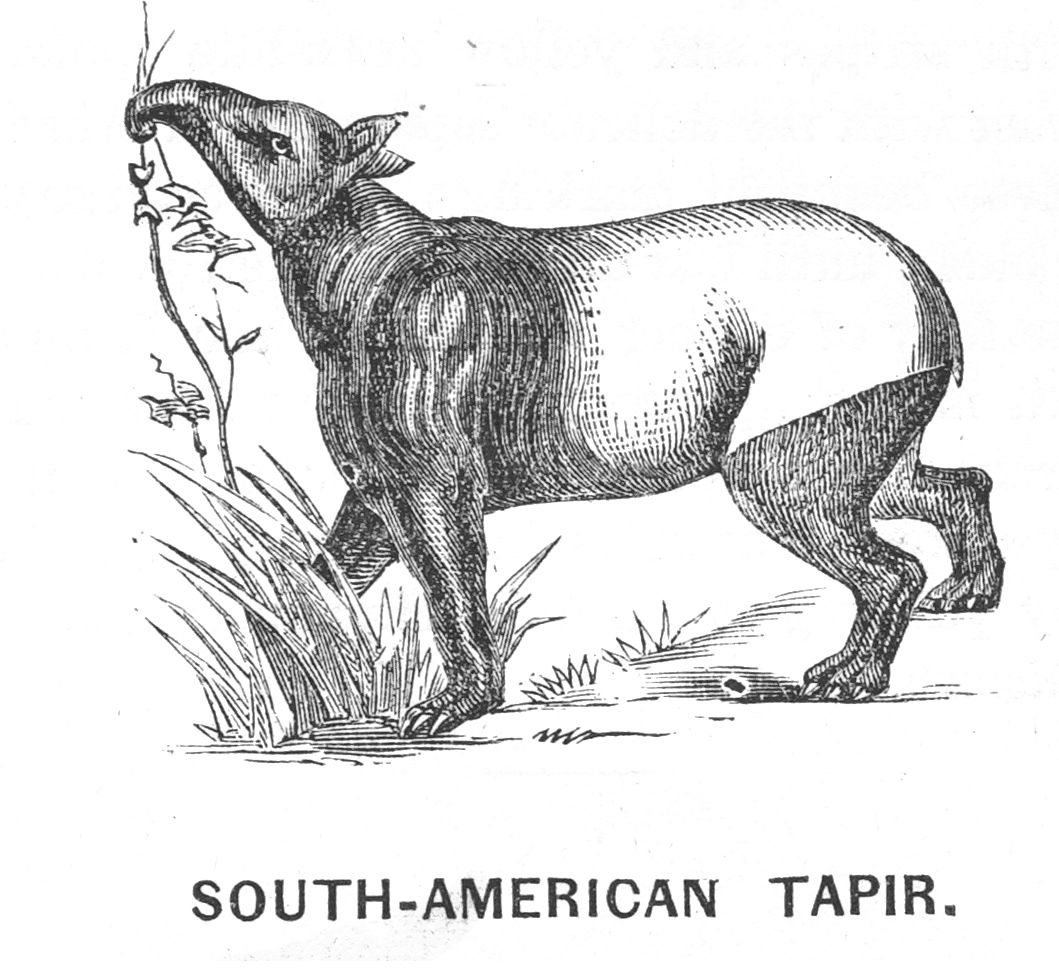
This Tapir is a transition from the elephant to the swine species, about half-way intermediate. There are but two varieties known to zoology, although fossiliferous remains of this animal testify to the fact that, at an early period of the world's history, other and much larger varieties had an existence. The Malayan Tapir exists in large numbers in Malacca and Sumatra; but, being a shy animal, inhabits the dense and inaccessible forests, where it is rarely seen, even by the natives. It is very fond of the water, and contents itself by walking on the bed of the stream only, as it is not an expert at swimming. The color of the adult Malayan Tapir is a dark sepia, almost black, except upon the rear portions of the back and haunches, where it is light, as if a white mantle had been dropped upon its back by some talismanic Elijah of the antediluvian period, giving it a strangely picturesque appearance. There have been very few of the Malayan species imported; they are, therefore, objects of great curiosity among the zoological collection. Indeed, managers of traveling menageries in this or any other country seldom think of assuming the risk or expense of procuring this animal, as well as numerous others which Mr. Barnum exhibits. '
HIPPOPOTAMUS. (Hippopotamus amphibius.)
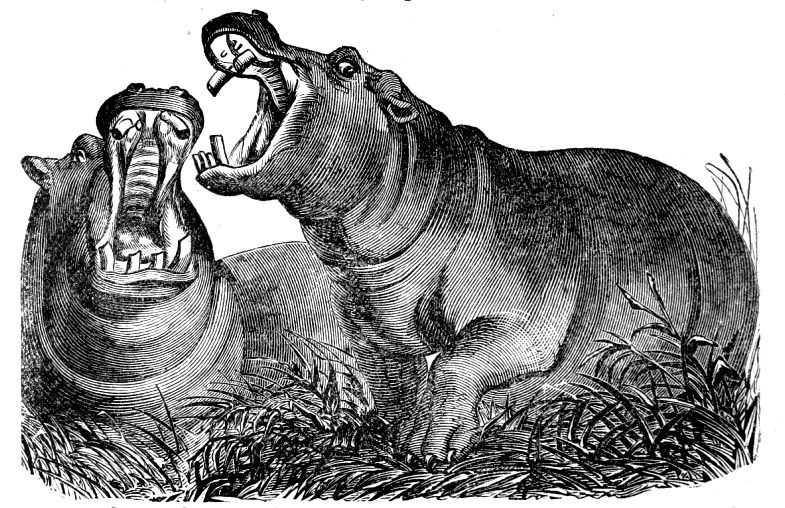
P. T. Barnum is entitled to the credit of being the first and only manager in America to secure and place on exhibition a live Hippopotamus. At great risk of life and property, and at an actual outlay of gold sufficient to constitute the ransom of a king, he introduced into his Museum, in 1860, one of these amphibious monsters from Africa; and the most money ever before made in one season by any traveling concern was in 1862, by Messrs. G. F. Bailey & Co,, who exhibited him throughout the Northern States and British Provinces, having leased the animal from the Great Show Prince for that purpose. There are several varieties found in all parts of Africa, always in proximity to rivers and streams of water, in which element they spend more than half their time sleeping or floundering, a terror to both land and marine monsters, and a havoc to all neighboring crops. Their legs are short, but their bodies are of enormous size. Their skin is of a dark reddish-brown color, full of cracks, chaps and cross-etchings, with dapplings of irregular dark spots on the sides and upper portion of the body. The skin is from one to two inches thick, full of pores, through which exudes a disagreeable oily substance - probably the brute's only antidote against disease, arising from its indiscriminate mixture and caperings in all kinds of malarious waters, which abound in the latitude of its habitation. They have been known to grow seventeen or eighteen feet in length, and from five to six feet in height. The enormous feet and tusks are formed scissors-like, with which they clip the vegetation upon which they feed, like a pair of shears. The tusks of the Hippopotamus, or River-horse, are very solid and compact, admirably adapted for making delicate philosophical apparatus and articles of dentistry. It is an expert swimmer, and, like the elephant, possesses the faculty of sinking or rising in the water at will. It is captured by means of traps, pitfalls, harpoons, and massive nets of rope - being able to capsize the largest vessels - used for this purpose. The appetite of this animal is voracious, having a stomach capable of stowing away five or six bushels of provender at a single meal. As its natural element is water, it will be readily seen how difficult and hazardous is the attempt to procure one of these marvelous beasts for exhibition in a traveling show, as it must always be supplied with a tank of water, out of which it will not exist for any length of time. No one but the liberal and audacious proprietor of this mammoth enterprise would think of providing the public with such a rare amphibious specimen of zoology, when the above-named facts are taken into consideration. And yet, in the face of all this, Mr. Barnum is determined that the people shall be gratified, by importing another Hippopotamus at the sacrifice of any time, money or expense. As an expedition has been fitted out expressly for that purpose, it will readily be seen that the cost of such an enterprise cannot fall short of $25,000.
VLACKE VARK, or ABYSSINIAN WART HOG.
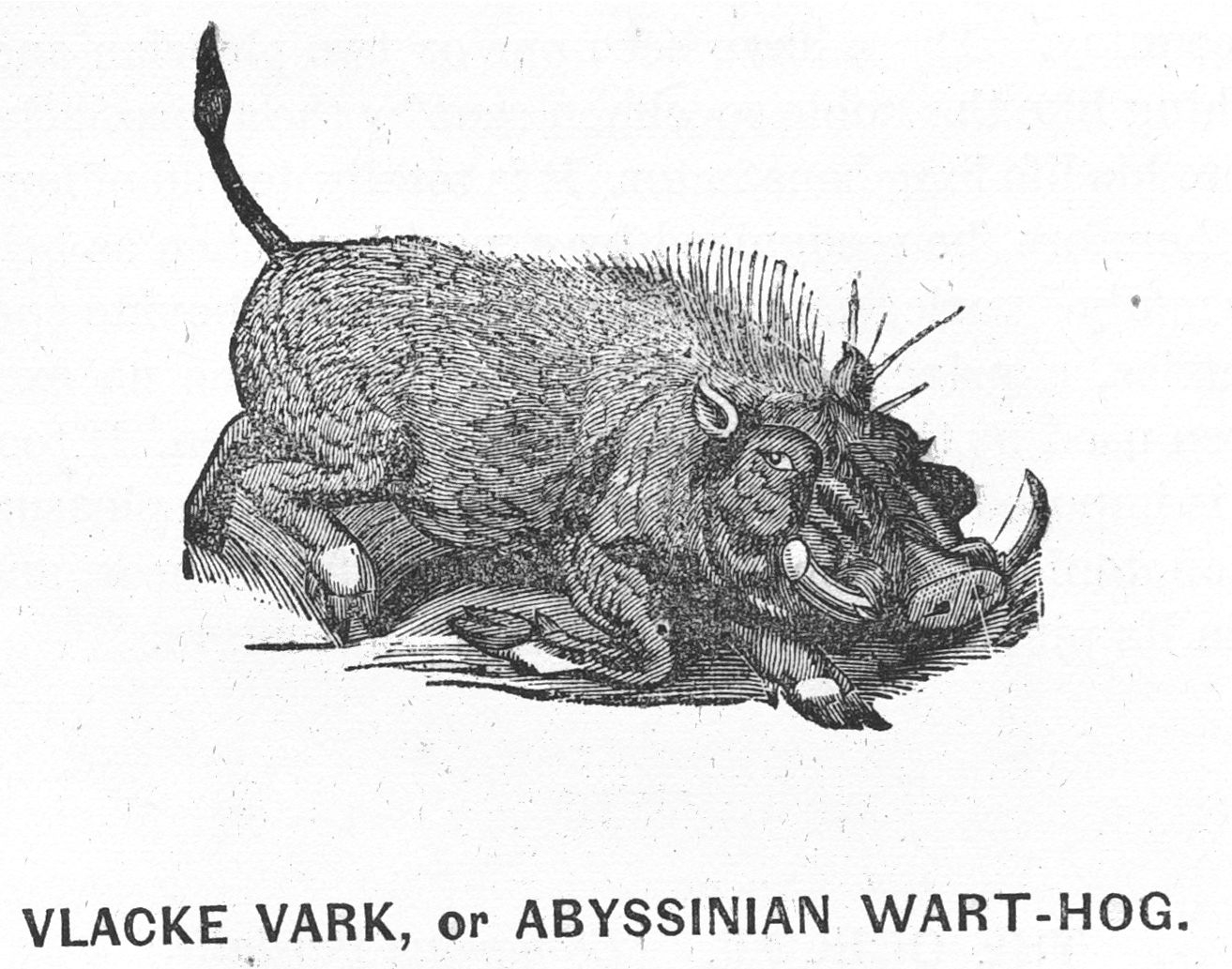
This animal belongs to the family of swine. In the conformation of its head it bears a striking resemblance to the hippopotamus, although smaller and more densely covered with hair and bristles. It is a formidable-looking beast, and seems to be an intermediate species between the rhinoceros and hippopotamus. The first specimens of this strange-looking animal were imported from Abyssinia to the Zoological Gardens in London, about twenty-five years ago. Mr. Barnum happened to be in London, exhibiting General Tom Thumb before Her Majesty Queen Victoria and her royal consort Prince Albert, besides many other of the crowned heads of Europe, when these Emgalla, or Abyssinian Wart Hogs, were first installed at the Royal Gardens, at Regent's Park, London. Of course, all the city was in excitement to see the marvelous nouveaux arrives from the unexplored regions of Abyssinia. The great American Show Prince --who always had an eye to business - noticing the interest and excitement which these beasts caused in London, determined to secure one or more for his American Museum in New York. But, as remarkable as it may appear, after a lapse of twenty-five years, he has but recently been able to ecure for his great Zoological Institute the first ever seen in America. It will be exhibited in conjunction with his Great Traveling Museum, Menagerie, Polytechnic Institute, International Zoological Garden and Hippodrome, during the traveling season.
The general color of the Vlacke Vark is of a blackish hue on the crown of its head and neck, and along the ridge of the back, and a dull brown on the remainder of the body, with a grayish tint upon the abdomen. The tusks of an adult male are about twelve inches long, and are a most terrible weapon. They have been known to cut a large-sized mastiff nearly in two, by a single stroke, or sever the fleshy parts of a man's thigh. Its retreating haunts are among the labyrinth of holes abandoned by ant-bears, into which it plunges back foremost, and suddenly disappears out of sight. The structure of the teeth is very curious, and well worthy scientific investigation. This animal is sometimes known as Ethiopian Wild Boar, or the Abyssinian Phacochaere, although it differs materially from that animal. It lives to the age of fifteen or twenty years, and is a terrible pest, on account of its frequent depredations. This specimen will be viewed as an object of great interest by naturalists.
THE MARSUPIALIA.
ORDER II, CLASS MAMMALIA.
This order derives its name from Marsupium, the Latin for purse or bag, the females of the several species which constitute it, having under their belly a pouch or sac, in which the young, which are born in a very immature state, are received and nourished, and whither they retreat long after they are able to move about. This family is divided into several families, and includes the Tasmanian Wolf, the Ursine Opossum, of Van Dieman's Land, the Spotted Marten, the Banded Ant-eater. the Common Opossum, and their numerous species, the Flying Squirrel, and the Kangaroo.
KANGAROO. (Macropus major.)
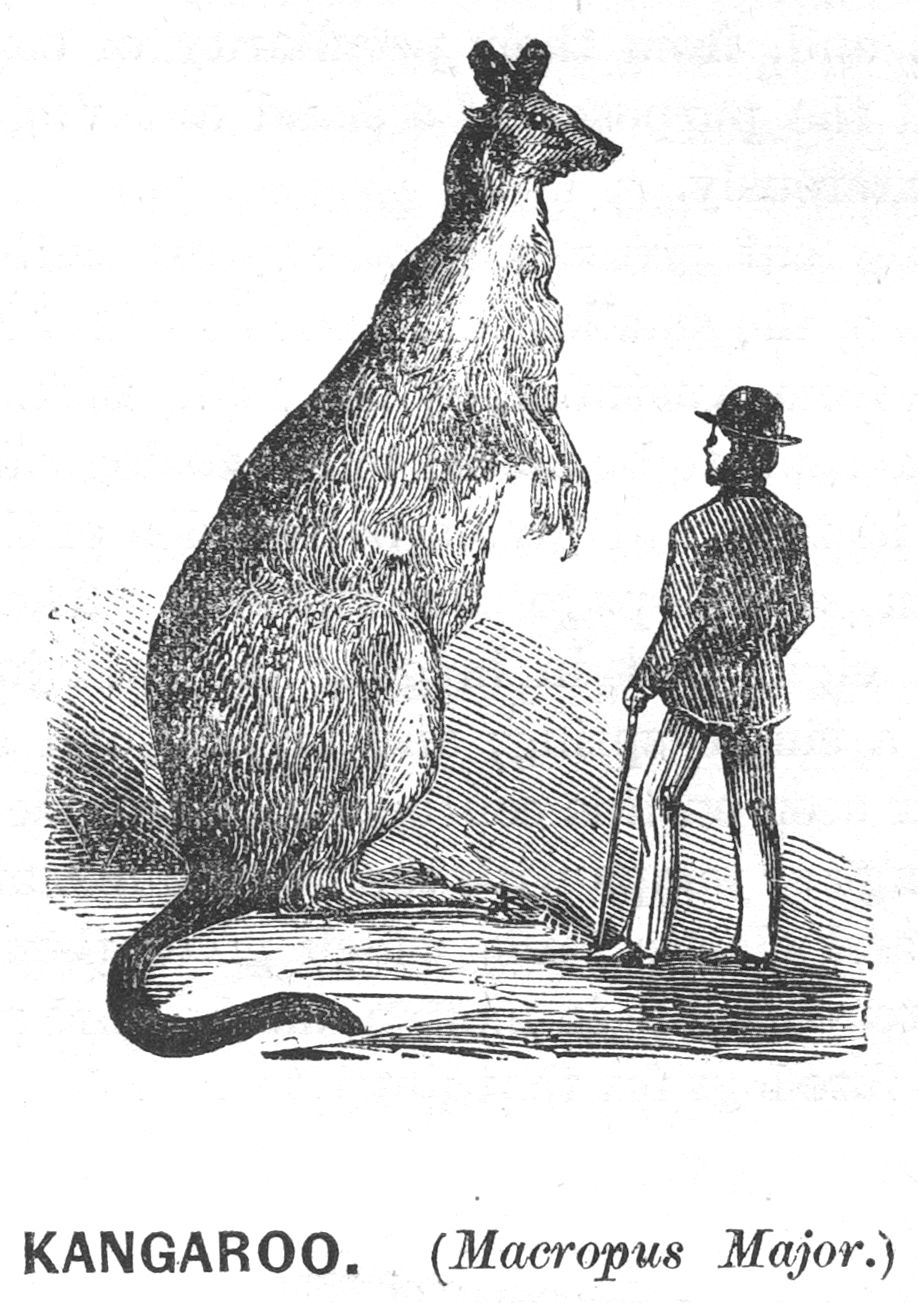
There are many varieties of Macropidae, the Kangaroo being the largest and most remarkable. These animals are called marsupial, from the fact that in the female there is a pouch, or marsupium, upon the external abdomen, in which the young, after birth, are safely housed and nourished, and whence they come and go with impunity, until they are about ten months of age; the number of young rarely exceeding two at a single birth. There are said to be eighty varieties of the Kangaroo, which is extremely doubtful. The largest and most noted of these are the Giganteus, Woolly, or Red Kangaroo; all others are mere sub-divisions of the same genus, the modifications being more in size than habits or characteristics. Among the smaller of the family may be mentioned the Kangaroo rat, hare, and the brush-tailed bettong. The Tree Kangaroo is so called from its well- known habit of climbing or springing into trees; while the Rock Kangaroo is known from its habits of isolation among the rocks and cliffs where it is often found separated from its more gregarious brethren, preferring darkness rather than light for its depredations. The color of these animals is an ashen-grey, with a gradation of shade, being lighter or darker in the different species; while upon the breast and abdomen of the doe, or female, there is no inconsiderable admixture of pure white. The fore-feet are black, and, from their peculiarity of conformation, answer very well the purposes of a hand and fingers, which they manipulate dexterously.
The above cut gives a good representation of a doe or female Kangaroo, the smallest of a pair of Giant Kangaroos sent to Mr. Barnum from Australia, by his little friend, General Tom Thumb, as a present to be added to his zoological collection. A glance at the picture will give a better idea of these interesting creatures than a full-page description. These magnificent specimens are eight feet in height, and will jump more than fifteen feet at a single spring, and are, beyond all controversy the largest ever seen on this continent. Their method of locomotion is by springs or jumps with the hind limbs, aided by the use of their long and elastic tails, which gives them an extremely comical appearance while in motion, as they are rarely known to use their short fore-legs for that purpose.
THE RODENTIA.
ORDER VIII, DIVISION V.
GENERAL CHARACTERS. - The Rodentia, or Gnawing Mammalia form the first of the truly unguiculate orders. They are all of small size – many of them the most diminutive of their class; but the species are exceedingly numerous and usually very prolific. The feed to a great extent upon hard substances, such as nuts, etc., and in order to get at their food they require both sharp and strong teeth They include Hares, Rabbits, Squirrels, Marmots, or Bear-rats, Woodchuck, .Ground Hogs, Prairie-dogs, Beavers, Guinea Pigs, the Agontis, the Carvy, the Capybara, the Porcupine, Egyptian Rat, Musk-rat, Mice and Rats.
THE CAPYBARA. (Hydrochaerus capybara.)
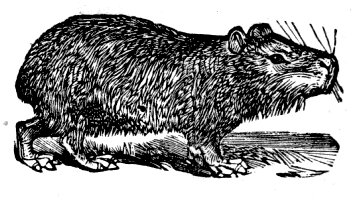
The Capybara has had various designations, such as Water-hog, Tailless Hippopotamus and Short-nosed Tapir. It is the largest species in the order, measuring about three feet in length. This animal has the appearance of a small pig, and its body is covered with bristles; it is an inhabitant of watery places in the warmer parts of South America, where it is generally seen in small flocks, and takes to the water when alarmed. It swims well, and the three toes of the hind-feet are united by a short swimming membrance. The flesh of this animal is very good, and it is said to be the favorite prey of the jaguar.
THE PORCUPINE. (Hystrix cristata.)
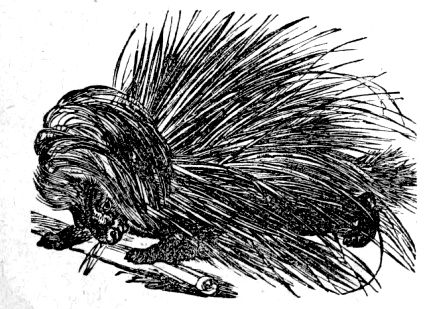
This animal, when full grown, is about two feet in length, The longest spines exceeding a foot. The general color is a grizzled dusky black, resulting from an intermixture of various shades of white, brown and black. It is almost entirely covered with spines, almost the thickness of a goose-quill, which terminate in sharp points, ringed alternately with black and white, the rings an inch or more broad. The usual position of the spines of the Porcupine is lying flat upon the body, with the points directed backward. When the animal is excited they are raised by means of the subcutaneous muscles, almost at right angles with his body, and then present a very formidable appearance. The spines cannot be detached by the animal. The Porcupine is a nocturnal animal, sleeping in a burrow which it digs, and to which there are several openings, during the day, and coming forth at nightfall to seek its food.
THE PINNIPEDIA.
ORDER IX.
SEA LION. (Otaria jubata.)

The Seal, Walrus, Sea Leopard, Sea Elephant, and Sea Lion belong to a maritime genus called Phocidae, and are remarkable for their habits as well as the formation of their bodies. They are found in the extreme northern solitudes of both hemispheres, their principal food consisting of fish. The Sea Lion is so called from its fancied resemblance to the royal quadruped which reigns supreme in Africa. It attains to from eight to ten feet in length, and when in good condition, weighs from eight hundred to a thousand pounds. The color of an adult male Sea Lion is a reddish-brown, which becomes paler with age. Upon the neck and shoulders grows a heavy mass of stuff - curly, crisp hair - bearing a striking resemblance to the lion. The female is devoid of this peculiar hirsute development. During the months of July and August these interesting creatures are found on the coast of Alaska, where they congregate in immense numbers to rear their young, which they watch with a jealous care during the first few weeks of their life.
Mr. Barnum is the first and only manager in America who ever conceived the project of introducing these remarkable animals as rare and curious objects for exhibition. The distance over which they must be transported, the difficulty of capturing them, and the expense and trouble attending their exhibition, render the project hazardous in the extreme. But, with the energy and indomitable perseverance of the great catering prince, nihil impossibile est. It seems to be his growing delight to accomplish what others dare not undertake, and to laugh at what less audacious managers call sheer impossibilities. The magnificent specimens in his Great Traveling Museum were captured recently in the North Pacific Ocean, and shipped to New York in massive water-tanks, at a cost of many thousand dollars. The largest of them weigh one thousand pounds each, and are over eight feet long. They consume about a hundred pounds of fresh fish every day. Mr. Barnum has eight of these living sea-monsters; part of them are kept in reserve in his colossal marine aquarium at Bridgeport, to supply any that might die. They are daily viewed by admiring thousands, as the finest specimens ever seen in this country.
THE LORICATA.
ORDER III, CLASS III.
THE EGYPTIAN CROCODILE. (Crocodilus vulgaris.)
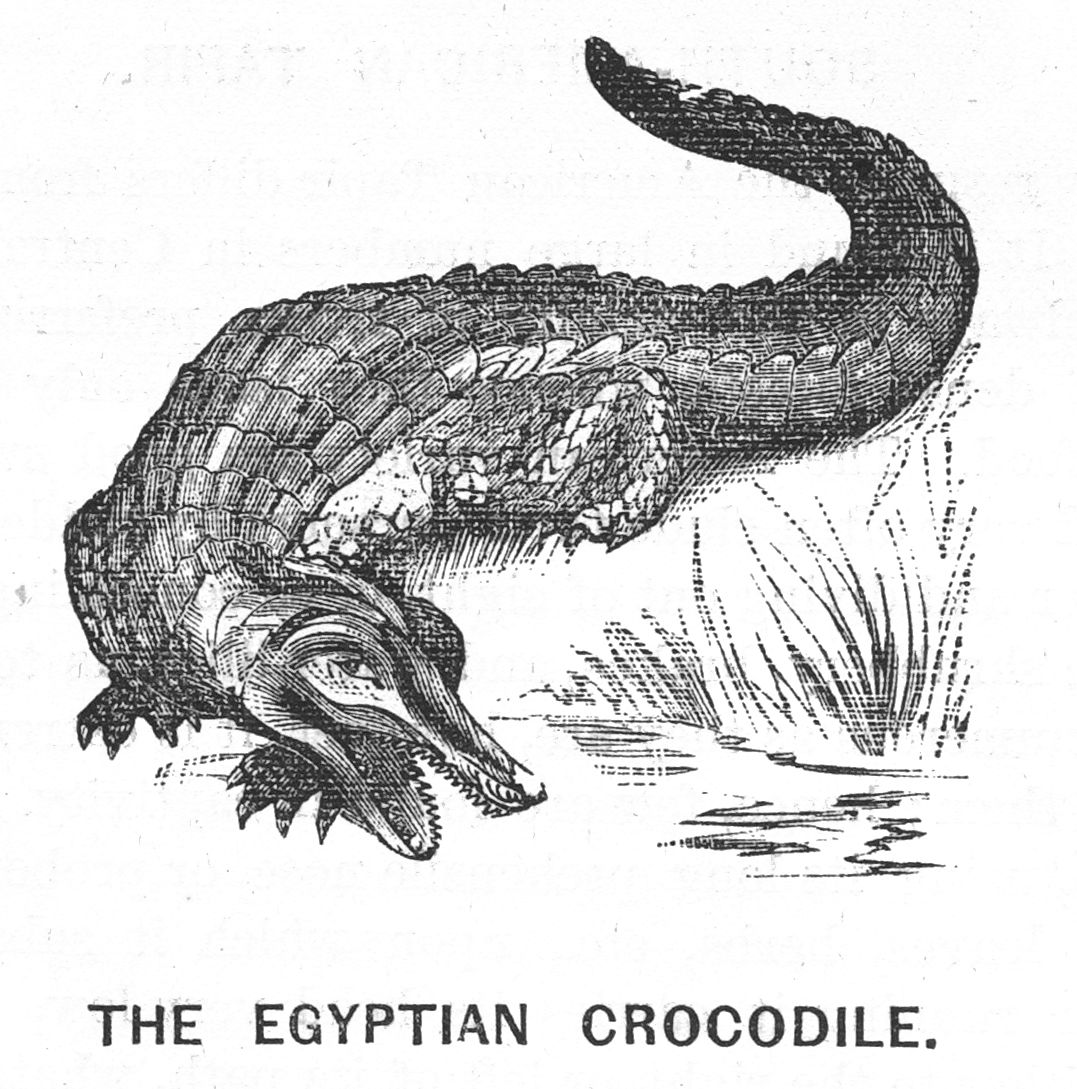
The Crocodile is a natural inhabitant of the river Nile and other Asiatic and African rivers. It is a carnivorous reptile, amphibious in habit, and belongs to the saurian group. It is of enormous size, strength, and voracity, a rapid swimmer, swift on foot, but, on account of its great length, slow to turn round. It will attack mankind, or any of the larger animals, with the most daring impetuosity. In proportion to size, it has the largest mouth of all living monsters known to ancient or modern zoology; moves equally the upper and lower jaw – that of the upper having forty, and the lower no less than thirty-eight massive teeth. It is liberally furnished with a thick coat of mail, so scaly and callous as to be absolutely impervious to the hardest bullet, the only vulnerable point being directly under the belly. They are generated from eggs resembling those of the goose, which the female deposits in the sand, two at a time, leaving them to incubate solely through the genial warmth of the sun and soil. They grow to a great length, averaging from sixteen to twenty feet when perfectly developed. The Crocodile from Egypt has a strange counterpart in America, in the family of El lagarto, corrupted from the Spanish by early English settlers into Alligator; it is not, however, identical with the Crocodile, although the difference is more specific than generic. Their comparative merits will be better judged of on examination, however, as the enterprising proprietor has procured, at a great sacrifice of labor and expense, species of these formidable-looking monsters from both Egypt in Africa and Florida in the United States.
THE OPHIDIA.
ORDER I. CLASS III.
GENERAL CHARACTERS. - Few animals appear to have been, in all ages, the objects of more general aversion than the creatures forming this order. Not to enter upon the question of possible theological grounds for their general disgust, we may take the statement in the book of Genesis, that "the serpent was more subtle than any other beast of the field," as a proof that at very early periods the stealthy, creeping movements of these creatures had obtained for them the same reputation , for cunning that they enjoy in the present day - a reputation which has caused . them to become one of the most common emblems of deceit.
BOA CONSTRICTOR. (Boidae.)
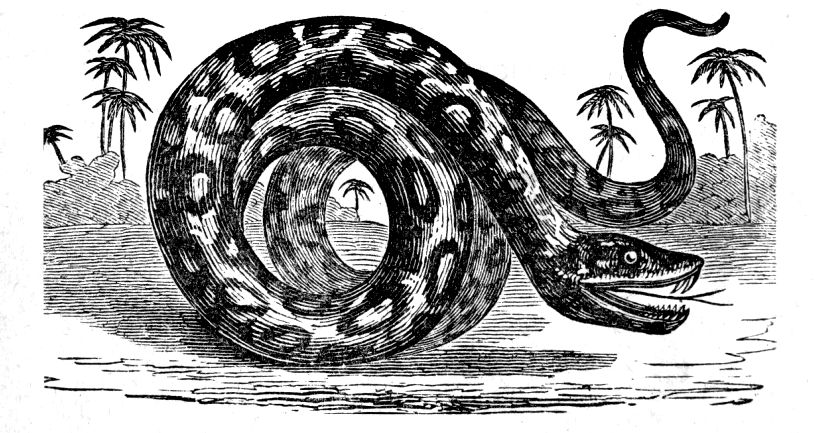
The extensive collection exhibited in Mr. Barnum's show are greater both in size and number than has ever before been gathered together under one roof. The thrilling spectacle of a human being entering the den of the Pythores and coiling their death-producing folds about his own body, is of itself an act of daring to be seen only under Mr. Barnum's management. These snakes attain a length of thirty feet, and an instance is on record of one measuring upwards of sixty feet in length, having been destroyed while in the act of coiling itself round a man who was lying asleep in a boat. The victim of the Boidae is destroyed by powerful compression, effected by the snake coiling its body round it, and then gradually tightening the folds. In this manner the body of the animal is reduced to a state fit for being swallowed; and this operation usually takes considerable time. One instance of the occurrence of a gigantic snake on the northern coast of Africa, is that of the serpent which is said to have thrown the army of Regulus into confusion, killing and devouring several of his soldiers. The historian tells us, that this formidable snake was only destroyed by assailing it with the military engines employed in the siege of fortified places. This serpent is said to have measured over one hundred feet; its skin was sent to Rome, when it was suspended in a temple, and remained for many years.
THE AVES, OR BIRDS.
CLASS IV.
China, Japan, South America and Australia furnish the handsomest rich-plumaged birds in the world. The aviary of this great show, so far as the birds are concerned, is the most complete in the world, while the extensive display of Parrots, Macaws, Golden-crested Cockatoos, Silver and Golden Pheasants, Horned and Albino Owls, Lyre Birds, Eagles and Condors, with a myriad tribe of songsters, must challenge the admiration of every visitor, as well as affording one of the most beautiful of the interesting studies found in natural history.
THE PELICAN. (Pelecanus onocrotalas.)
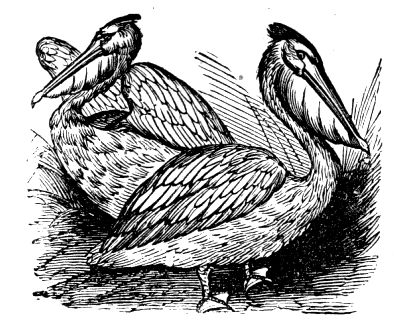
The Pelican measures from five to six feet in length, with an expanse of wing of from twelve to thirteen feet. They live on the banks of levers and lakes and on sea-shores. They swim and fly well, and are able to perch upon trees. The skin beneath the lower bill or mandible, is dilated into a large pouch, in which they store the fish they capture. When fishing, the Pelicans fly over the water at a height of twenty to forty feet, until they see a fish near enough to the surface, when they immediately dart upon it with most unerring certainty, store it away in the pouch, and proceed in search of more. It is found in the east of Europe, Asia and Africa. In feeding their young, the Pelicans are said to press the pouch against the breast to assist in disgorgement of the prey; and it is supposed that the contrast of the red tip of the bill to the snowy feathers of the breast, when the birds are thus engaged, must have given rise to the poetical notion which prevailed amongst the ancients that the female Pelican was feeding her young with her blood.
THE INDIAN ADJUTANT. (Leptopilus argala.)
The Adjutant is the name given to this bird by the English residents of India, of which country it is a native. It is of large size, having extremely longs legs, and in erect attitude is upwards of six feet high, its extended wings measuring fifteen feet from tip to tip. Its head and neck are nearly bare, a sausage-like pouch hangs from the under part of its neck, and its bill is enormous. These extraordinary and uncouth-looking birds have only been known to naturalists for about twenty years and the subjects of this sketch are believed to be the only ones ever exhibited in America. The upper part of the thighs furnish the beautiful plumes, superior, in estimation, even to those of the ostrich. It is very voracious, and will swallow cats and rats quite readily, and is of great use in devouring snakes and lizards - these are usually swallowed entire. It is also very fond of fish, which it watches for from a fixed station in a sheltered nook by the side of the river, a projecting rock by the sea-side, over deep water, or standing in the stream when the current is not so powerful as to preclude the possibility of its remaining stationary.
THE OSTRICH. {Struthio camelus.)

The Touyou or American Ostrich is the largest bird upon the American Continent and was at one time found in large numbers upon all the South American steppes. As civilization increased, the bird fled from the march of the pioneer, until it has become almost extinct in certain sections, where it once roamed in flocks.
The plumage is mostly gray, with delicate white feathers under the wings and upon the umbilical regions. These feathers are choice, and constitute the Mirabeau head ornaments so much admired and worn by fashionable ladies.
The black African Ostrich is polygamous, the male usually associating with from two to six females. The hens lay all their eggs together - each from ten to twelve - in one nest, this being merely a shallow cavity scraped in the ground, of such dimensions as to be conveniently covered by one of these gigantic birds in incubation. The hens relieve each other in the task of incubation during the day, giving the male charge at night, as his superior strength enables him to protect the eggs or the newly-fledged birds from the jackals, tiger-cats, and other enemies. It is fleet upon foot, and gives its pursuers a long and difficult race. When overcome by hunters, it fights desperately, striking them with its wings, and frequently inflicting terrible blows. It can, when taken young, be rendered docile for a time; but, as it advances in years, it resumes its natural, repulsive belligerent disposition. The specimen exhibited in this menagerie is the only male Ostrich ever exhibited, and the largest now on exhibition at or in any place.
THE CASSOWARY. (Casuarius galeatus.)
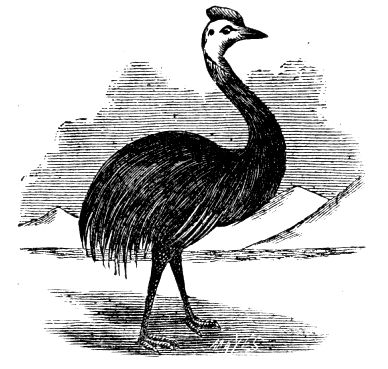
The Cassowary is an inhabitant of the islands of the Eastern Archipelago. It stands five feet in height, and is distinguished from the other members of the feathered tribe by the possession of a very peculiar horny crest or helmet upon the head, by the wings being furnished, instead of with feathers, with about five cylindrical stalks, destitute of barbs, and by the large claw on the inner toe. The head and neck are naked and wattled, and these parts are of a bright red color variegated with blue. The body, which is very stout, is covered with long pendent feathers, which resemble hair even more closely than those of the emeu.
THE EMEU.
The Emeu of New Holland is nearly as large as the African ostrich, measuring from five to seven feet in height. It has three toes on each foot, and these are furnished with nearly equal claws; the head is covered with feathers, but the throat is naked, and the plumage of the body closely resembles long hairs hanging down on each side of the body from a central line, or parting. The neck is covered with feathers. These birds are abundantin the southern parts of Australia. The only pair ever exhibited in this country are to be seen with this mammoth menagerie.
CRESTED COCKATOOS.
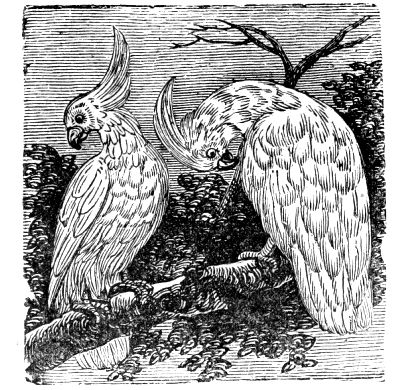
These birds are natives of Australia and the Indian Islands, where they live in the forests far from the habitation of man, feeding upon seed and soft and stony fruit which their powerful beaks enable them to break with ease. Like most other birds of their species, they make their nests in the hollow of decayed trees, and are easily domesticated and become familiar and even attached to persons, but their imitative powers seldom go beyond a very few words (added to their own cry of "cockatoo"), which they are taught to pronounce very distinctly if properly instructed at an early age.
SPANISH MACAWS.
The Macaw is remarkable for its beautiful color, powerful bill and fleshy tongue, and the power of imitating the human voice. Indeed, their articulation is so perfect that when the bird is unseen it is difficult to suppose that the sounds are not from man. The plumage of this extensive family is of the most rich and varied description, embracing almost every color and gradation of tint. The true Macaws are inhabitants of the torrid zone. The great Green Macaw inhabits the warm district of the chain of the Andes, and is often found at an elevation of three thousand feet. They generally live in pairs; but the blue and yellow Macaws sometimes assemble in large flocks, their favorite haunts being swampy woods.
MUSEUM AND HUMAN CURIOSITIES
In addition to the catalogue of leading Wild Animals in Bamum's Circus and Menagerie, a brief description and illustration of which are given in the preceding pages of this pamphlet, the Museum Department of the same great Traveling Exposition of the Wonder World contains many thousands of living and representative curiosities from all parts of the earth, gathered at an enormous expenditure of time and means, and exhibited for the first time under canvas.
At the time of writing this, Mr. G. F. Bailey, accompanied by Prof. W. Jukes, is in Europe securing a vast amount of novelties.
We have neither the time nor the space to give more than a brief description of a few of the leading features of this diversified melange of the prodigious and unique. Visitors to this department of the exhibition, through the aid of this brief catalogue, will be better prepared to judge of the merits of the entertainment, and to form an intelligent conception of the numerous leading objects placed on exhibition.
The Mysterious Lady - Is She Alive? - This remarkable feature of the Museum is one of the most attractive as well as mysterious effects ever presented to the public. The perfectly-formed bust of a beautiful lady is plainly visible resting upon a table. The visitor can see under and around the table, but the lower part of the lady, from the waist down, is invisible. The lady fans herself, smiles, moves her eyes and serenely reads her book. Common sense teaches the visitor that it would be impossible for a human being to live in the condition in which the mysterious lady exists. "Is she alive?" will create as much discussion as did Mr. Barnum's "What is it?"
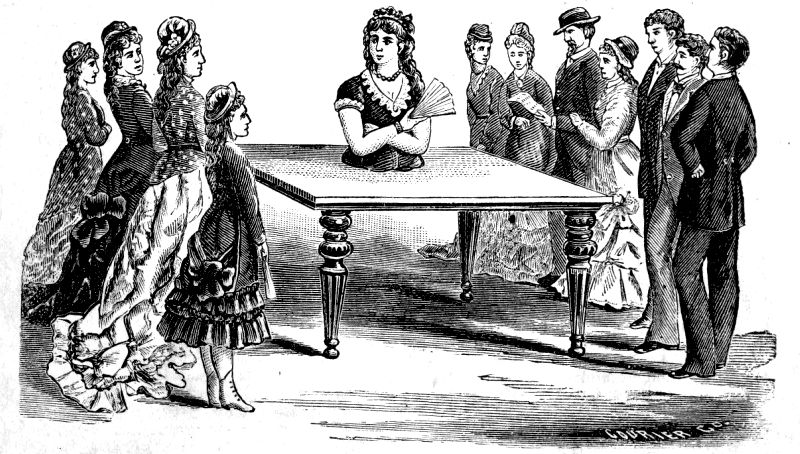
Giants and Dwarfs. - Towering above all other human curiosities the visitor will notice Col. Ruth Goshen, the Palestine Giant, forty-three years of age, weighing 620 pounds and seven feet eleven inches in height, he forms a striking contrast to ordinary man kind.
Of all the dwarfs which Mr. Barnum has introduced to the public, Nellie Keeler, the Indiana Midget, is most perfect. She is thirteen years of age, stands but twenty-four inches in height, and weighs but thirty pounds. Nellie is bright and intelligent.
Gideon's Band. - This triumph of mechanical ingenuity represents a full brass band. The heads of each individual are grotesque in appearance, the eyes move, the cheeks swell and contract. Every motion necessary for the production of music is faithfully reproduced. From "Old Gideon," who keeps time for his comic band, to the swell drummer "Tommy, the masher," the visitor will notice the work of the master artist. This wonderful production cost Mr. Barnum $10,000.
Automaton Musical Animals. - Consisting of monkey violinist, musical rabbit, cat and bear, strictly mechanical, and so adroitly and skillfully made as nearly to defy detection, being an infinite source of delight to the little folks, if not to the "children" of mature growth.
Automaton Gymnast, Drummer, and Trumpeter. - These remarkable figures are entirely mechanical. The Gymnast is made to accomplish all the difficult and hazardous feats of the great Leotard; the Drummer performs marvelously upon the drum, playing such pieces as the spectators may select, looks around upon the audience, answers questions in geography, arithmetic, history, etc., and surprises everybody at the facility and precision of all its skillful accomplishments with the drum. The Trumpeter is also a very elaborate piece of mechanism, made by the celebrated M. Houdin, of Paris; plays beautiful and harmonious melodies with the trumpet, whose clarion notes fairly eclipse that of Ehud, the famous trumpeter of Israel. It is really astonishing to see what genius and mechan ism have wrought in giving apparent life and animation to inanimate things.
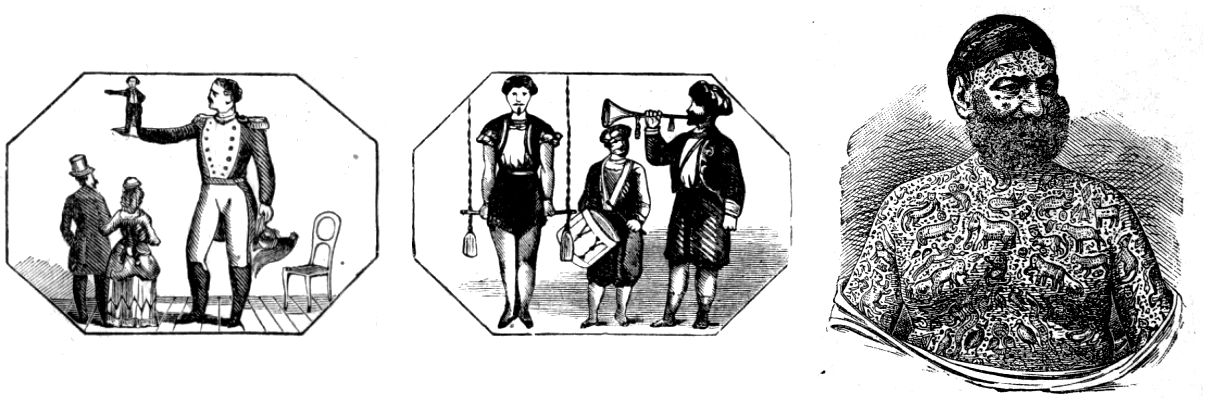
Mechanical Bell-Ringers. - Life-size, beautifully draped, play the most charming melodies on silver bells. These seven young ladies are all strictly mechanical; they turn their heads in different directions, and execute the most difficult pieces of music on bells, by request of the spectators.
Mechanical Singing Birds. - Perfectly natural and life-like, it being impossible to detect the notes or movements of the birds from the sweetest living nightingale or canaries. A diminutive piece of mechanism is inclosed within the natural skin and feathery integument of the most exquisitely plumed of the tiny songsters, by means of which the delicate little warblers trill their dulcet notes, which are perfectly rapturous and enchanting. A mammoth rooster crows as he plays the sweet guitar.
The Tattooed Man. - Conspicuous among the wonders is that Miracle of Mortal Marvels, Capt. GEORGES COSTENTENUS, a Noble Greek Albanian, TATTOOED FROM HEAD TO FOOT in Chinese Tartary, as .punishment for engaging in rebellion against the king. Every inch of his body is covered with 388 BEAUTIFULLY DELINEATED FIGURES, IN INDIGO AND CINNABAR, of Beasts, Birds, Fishes, Reptiles and Hieroglyphics, the prolonged and horrible agony of this combination of barbaric art and vengeance necessitating OVER SEVEN MILLION BLOOD PRODUCING PUNCTURES!
Our Clog Dancers. - Two colored persons are represented dancing, with all the actions of human beings, the dance of the "Sunny South." As the musical steam calliope peals forth its thundering music, Jim Crow and wife keep time with feet that never tire.
Ancient Arms. - Swords, anchos, lance, missiles, long and broad swords and shields, arrows, darts, quivers, and many weapons of personal combat and international warfare used by the Ancient Greeks and Romans, Persians, and Hindoos.
In addition to the objects of special interest, which have been faintly illustrated by means of pictures, drawings, and designs by our artist, the Museum Department contains many rare curiosities, which will be viewed with interest by historians, naturalists, archaeologists, ornithologists, geologists, conchologists, paleontologists, zoologists, and ichthyologists of every conceivable shade of opinion, whether they have attained to heights of eminence in these specialties or occupy a more humble position in the empire of the unknown.
